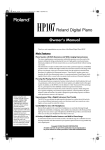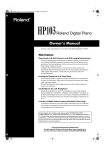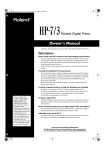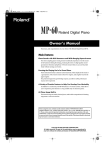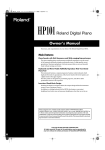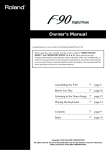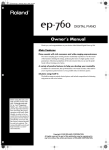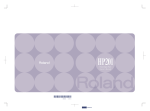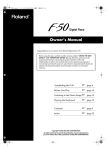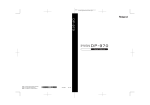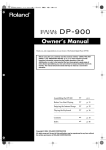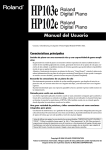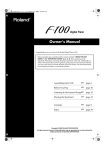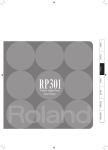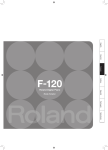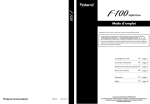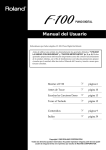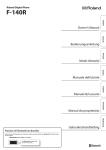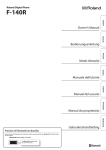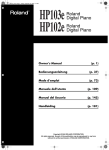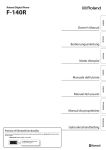Download Roland MP-70 Musical Instrument User Manual
Transcript
MP-70_e.book 1 ページ 2006年3月29日 水曜日 午後4時17分 Owner’s Manual Thank you, and congratulations on your choice of the Roland Digital Piano MP-70. Main Features Piano Sounds with Rich Resonance and Wide-Ranging Expressiveness The stereo sampling piano sound generator realistically reproduces even the sound of the hammers striking the strings, producing the tones of a high-quality concert grand piano. Maximum polyphony of 64 notes ensures that you can use the pedal freely without running out of notes. Pursuing the Playing Feel of a Grand Piano These instruments feature a compact progressive hammer action keyboard, which duplicates the touch of a grand piano, with a heavier touch in the lower register, and a lighter touch in the upper register. The pedal is designed for good-feeling response, and allows subtle performance nuances to be expressed. A Variety of Practice Features to Help You Develop Your Musicality In addition to a metronome, the MP-70 features a two-track recorder, which allows you to experience piano lessons in a way possible only on electronic pianos. 66 Piano Songs Built-In The internal songs are mainly classical pieces, and include compositions for listening enjoyment as well as for lessons. Before using this unit, carefully read the sections entitled: “IMPORTANT SAFETY INSTRUCTIONS” (p. 2), “USING THE UNIT SAFELY” (p. 3, 4), and “IMPORTANT NOTES” (p. 5). These sections provide important information concerning the proper operation of the unit. Additionally, in order to feel assured that you have gained a good grasp of every feature provided by your new unit, Owner’s manual should be read in its entirety. The manual should be saved and kept on hand as a convenient reference. Copyright © 2006 ROLAND CORPORATION All rights reserved. No part of this publication may be reproduced in any form without the written permission of ROLAND CORPORATION. MP-70_e.book 2 ページ 2006年3月29日 水曜日 午後4時17分 WARNING: To reduce the risk of fire or electric shock, do not expose this apparatus to rain or moisture. CAUTION RISK OF ELECTRIC SHOCK DO NOT OPEN ATTENTION: RISQUE DE CHOC ELECTRIQUE NE PAS OUVRIR CAUTION: TO REDUCE THE RISK OF ELECTRIC SHOCK, DO NOT REMOVE COVER (OR BACK). NO USER-SERVICEABLE PARTS INSIDE. REFER SERVICING TO QUALIFIED SERVICE PERSONNEL. The lightning flash with arrowhead symbol, within an equilateral triangle, is intended to alert the user to the presence of uninsulated “dangerous voltage” within the product’s enclosure that may be of sufficient magnitude to constitute a risk of electric shock to persons. The exclamation point within an equilateral triangle is intended to alert the user to the presence of important operating and maintenance (servicing) instructions in the literature accompanying the product. INSTRUCTIONS PERTAINING TO A RISK OF FIRE, ELECTRIC SHOCK, OR INJURY TO PERSONS. IMPORTANT SAFETY INSTRUCTIONS SAVE THESE INSTRUCTIONS WARNING - When using electric products, basic precautions should always be followed, including the following: 1. 2. 3. 4. 5. 6. 7. 8. 9. Read these instructions. Keep these instructions. Heed all warnings. Follow all instructions. Do not use this apparatus near water. Clean only with a dry cloth. Do not block any of the ventilation openings. Install in accordance with the manufacturers instructions. Do not install near any heat sources such as radiators, heat registers, stoves, or other apparatus (including amplifiers) that produce heat. Do not defeat the safety purpose of the polarized or grounding-type plug. A polarized plug has two blades with one wider than the other. A grounding type plug has two blades and a third grounding prong. The wide blade or the third prong are provided for your safety. If the provided plug does not fit into your outlet, consult an electrician for replacement of the obsolete outlet. 10. Protect the power cord from being walked on or pinched particularly at plugs, convenience receptacles, and the point where they exit from the apparatus. 11. Only use attachments/accessories specified by the manufacturer. 12. Use only with the cart, stand, tripod, bracket, or table specified by the manufacturer, or sold with the apparatus. When a cart is used, use caution when moving the cart/apparatus combination to avoid injury from tip-over. 13. Unplug this apparatus during lightning storms or when unused for long periods of time. 14. Refer all servicing to qualified service personnel. Servicing is required when the apparatus has been damaged in any way, such as power-supply cord or plug is damaged, liquid has been spilled or objects have fallen into the apparatus, the apparatus has been exposed to rain or moisture, does not operate normally, or has been dropped. For the U.K. IMPORTANT: THE WIRES IN THIS MAINS LEAD ARE COLOURED IN ACCORDANCE WITH THE FOLLOWING CODE. BLUE: NEUTRAL BROWN: LIVE As the colours of the wires in the mains lead of this apparatus may not correspond with the coloured markings identifying the terminals in your plug, proceed as follows: The wire which is coloured BLUE must be connected to the terminal which is marked with the letter N or coloured BLACK. The wire which is coloured BROWN must be connected to the terminal which is marked with the letter L or coloured RED. Under no circumstances must either of the above wires be connected to the earth terminal of a three pin plug. 2 MP-70_e.book 3 ページ 2006年3月29日 水曜日 午後4時17分 USING THE UNIT SAFELY The symbol alerts the user to important instructions or warnings.The specific meaning of the symbol is determined by the design contained within the triangle. In the case of the symbol at left, it is used for general cautions, warnings, or alerts to danger. Used for instructions intended to alert the user to the risk of death or severe injury should the unit be used improperly. Used for instructions intended to alert the user to the risk of injury or material damage should the unit be used improperly. * Material damage refers other adverse effects respect to the home furnishings, as well animals or pets. to damage or caused with and all its to domestic 001 • The symbol alerts the user to items that must never be carried out (are forbidden). The specific thing that must not be done is indicated by the design contained within the circle. In the case of the symbol at left, it means that the unit must never be disassembled. The ● symbol alerts the user to things that must be carried out. The specific thing that must be done is indicated by the design contained within the circle. In the case of the symbol at left, it means that the powercord plug must be unplugged from the outlet. 010 Before using this unit, make sure to read the instructions below, and the Owner’s Manual. • .......................................................................................................... 002a • Do not open or perform any internal modifications on the unit. .......................................................................................................... 003 • Do not attempt to repair the unit, or replace parts within it (except when this manual provides specific instructions directing you to do so). Refer all servicing to your retailer, the nearest Roland Service Center, or an authorized Roland distributor, as listed on the “Information” page. .......................................................................................................... 004 • Never use or store the unit in places that are: • Subject to temperature extremes (e.g., direct sunlight in an enclosed vehicle, near a heating duct, on top of heat-generating equipment); or are • Damp (e.g., baths, washrooms, on wet floors); or are • Humid; or are • Exposed to rain; or are • Dusty; or are • Subject to high levels of vibration. .......................................................................................................... 011 • .......................................................................................................... • .......................................................................................................... Make sure you always have the unit placed so it is level and sure to remain stable. Never place it on stands that could wobble, or on inclined surfaces. .......................................................................................................... 008a • The unit should be connected to a power supply only of the type described in the operating instructions, or as marked on the bottom of unit. .......................................................................................................... • .......................................................................................................... Use only the attached power-supply cord. Also, the supplied power cord must not be used with any other device. .......................................................................................................... Immediately turn the power off, remove the power cord from the outlet, and request servicing by your retailer, the nearest Roland Service Center, or an authorized Roland distributor, as listed on the “Information” page when: • The power-supply cord, or the plug has been damaged; or • If smoke or unusual odor occurs • Objects have fallen into, or liquid has been spilled onto the unit; or • The unit has been exposed to rain (or otherwise has become wet); or • The unit does not appear to operate normally or exhibits a marked change in performance. 013 008e • Do not allow any objects (e.g., flammable material, coins, pins); or liquids of any kind (water, soft drinks, etc.) to penetrate the unit. 012a 007 • This unit, either alone or in combination with an amplifier and headphones or speakers, may be capable of producing sound levels that could cause permanent hearing loss. Do not operate for a long period of time at a high volume level, or at a level that is uncomfortable. If you experience any hearing loss or ringing in the ears, you should immediately stop using the unit, and consult an audiologist. In households with small children, an adult should provide supervision until the child is capable of following all the rules essential for the safe operation of the unit. .......................................................................................................... 014 • Protect the unit from strong impact. (Do not drop it!) 009 • Do not excessively twist or bend the power cord, nor place heavy objects on it. Doing so can damage the cord, producing severed elements and short circuits. Damaged cords are fire and shock hazards! 3 MP-70_e.book 4 ページ 2006年3月29日 水曜日 午後4時17分 015 • 101a Do not force the unit’s power-supply cord to share an outlet with an unreasonable number of other devices. Be especially careful when using extension cords—the total power used by all devices you have connected to the extension cord’s outlet must never exceed the power rating (watts/amperes) for the extension cord. Excessive loads can cause the insulation on the cord to heat up and eventually melt through. .......................................................................................................... 016 • Before using the unit in a foreign country, consult with your retailer, the nearest Roland Service Center, or an authorized Roland distributor, as listed on the “Information” page. • .......................................................................................................... 102b • .......................................................................................................... • .......................................................................................................... Do not put anything that contains water (e.g., flower vases) on this unit. Also, avoid the use of insecticides, perfumes, alcohol, nail polish, spray cans, etc., near the unit. Swiftly wipe away any liquid that spills on the unit using a dry, soft cloth. Always grasp only the plug on the power-supply cord when plugging into, or unplugging from, an outlet or this unit. 103a 026 • The unit should be located so that its location or position does not interfere with its proper ventilation. At regular intervals, you should unplug the power plug and clean it by using a dry cloth to wipe all dust and other accumulations away from its prongs. Also, disconnect the power plug from the power outlet whenever the unit is to remain unused for an extended period of time. Any accumulation of dust between the power plug and the power outlet can result in poor insulation and lead to fire. .......................................................................................................... 104 • Try to prevent cords and cables from becoming entangled. Also, all cords and cables should be placed so they are out of the reach of children. .......................................................................................................... 106 • Never climb on top of, nor place heavy objects on the unit. .......................................................................................................... 107b • Never handle the power cord or its plugs with wet hands when plugging into, or unplugging from, an outlet or this unit. .......................................................................................................... 108d: Selection • If you need to move the instrument, take note of the precautions listed below. At least two persons are required to safely lift and move the unit. It should be handled carefully, all the while keeping it level. Make sure to have a firm grip, to protect yourself from injury and the instrument from damage. 1 • Check to make sure the screws securing the unit to the stand have not become loose. Fasten them again securely whenever you notice any loosening. 2 • Disconnect the power cord. 3 • Disconnect all cords coming from external devices. 4 • Raise the adjusters on the stand (p. 10). 5 • Close the lid. 6 • Remove the music stand. .......................................................................................................... 109a • Before cleaning the unit, turn off the power and unplug the power cord from the outlet (p. 8). .......................................................................................................... 110a • Whenever you suspect the possibility of lightning in your area, pull the plug on the power cord out of the outlet. .......................................................................................................... 116 • Be careful when opening/closing the lid so you do not get your fingers pinched (p. 8). Adult supervision is recommended whenever small children use the unit. .......................................................................................................... 118c • 4 Keep any wing nut you may remove and the included screws of stand in a safe place out of children’s reach, so there is no chance of them being swallowed accidentally. MP-70_e.book 5 ページ 2006年3月29日 水曜日 午後4時17分 IMPORTANT NOTES 291b In addition to the items listed under “IMPORTANT SAFETY INSTRUCTIONS” and “USING THE UNIT SAFELY” on pages 3 and 4, please read and observe the following: Power Supply Maintenance 301 401b • Do not connect this unit to same electrical outlet that is being used by an electrical appliance that is controlled by an inverter (such as a refrigerator, washing machine, microwave oven, or air conditioner), or that contains a motor. Depending on the way in which the electrical appliance is used, power supply noise may cause this unit to malfunction or may produce audible noise. If it is not practical to use a separate electrical outlet, connect a power supply noise filter between this unit and the electrical outlet. • To clean the unit, use a dry, soft cloth; or one that is slightly dampened. Try to wipe the entire surface using an equal amount of strength, moving the cloth along with the grain of the wood. Rubbing too hard in the same area can damage the finish. 307 • Before connecting this unit to other devices, turn off the power to all units. This will help prevent malfunctions and/or damage to speakers or other devices. 402 • Never use benzine, thinners, alcohol or solvents of any kind, to avoid the possibility of discoloration and/or deformation. 403 • The pedals of this unit are made of brass. Brass eventually darkens as the result of the natural oxidization process. If the brass becomes tarnished, polish it using commercially available metal polisher. 308 • Although the LCD and LEDs are switched off when the POWER switch is switched off, this does not mean that the unit has been completely disconnected from the source of power. If you need to turn off the power completely, first turn off the POWER switch, then unplug the power cord from the power outlet. For this reason, the outlet into which you choose to connect the power cord’s plug should be one that is within easy reach and readily accessible. Placement 351 • Using the unit near power amplifiers (or other equipment containing large power transformers) may induce hum. To alleviate the problem, change the orientation of this unit; or move it farther away from the source of interference. 352a • This device may interfere with radio and television reception. Do not use this device in the vicinity of such receivers. 352b • Noise may be produced if wireless communications devices, such as cell phones, are operated in the vicinity of this unit. Such noise could occur when receiving or initiating a call, or while conversing. Should you experience such problems, you should relocate such wireless devices so they are at a greater distance from this unit, or switch them off. 354b • Do not expose the unit to direct sunlight, place it near devices that radiate heat, leave it inside an enclosed vehicle, or otherwise subject it to temperature extremes. Also, do not allow lighting devices that normally are used while their light source is very close to the unit (such as a piano light), or powerful spotlights to shine upon the same area of the unit for extended periods of time. Excessive heat can deform or discolor the unit. 355b • When moved from one location to another where the temperature and/or humidity is very different, water droplets (condensation) may form inside the unit. Damage or malfunction may result if you attempt to use the unit in this condition. Therefore, before using the unit, you must allow it to stand for several hours, until the condensation has completely evaporated. 356 • Do not allow rubber, vinyl, or similar materials to remain on the unit for long periods of time. Such objects can discolor or otherwise harmfully affect the finish. Additional Precautions 553 • Use a reasonable amount of care when using the unit’s buttons, sliders, or other controls; and when using its jacks and connectors. Rough handling can lead to malfunctions. 556 • When connecting / disconnecting all cables, grasp the connector itself—never pull on the cable. This way you will avoid causing shorts, or damage to the cable’s internal elements. 557 • A small amount of heat will radiate from the unit during normal operation. 558a • To avoid disturbing your neighbors, try to keep the unit’s volume at reasonable levels. You may prefer to use headphones, so you do not need to be concerned about those around you (especially when it is late at night). 559b • When you need to transport the unit, pack it in shock-absorbent material. Transporting the unit without doing so can cause it to become scratched or damaged, and could lead to malfunction. 560 • Do not apply undue force to the music stand while it is in use. 562 • Use a cable from Roland to make the connection. If using some other make of connection cable, please note the following precautions. • Some connection cables contain resistors. Do not use cables that incorporate resistors for connecting to this unit. The use of such cables can cause the sound level to be extremely low, or impossible to hear. For information on cable specifications, contact the manufacturer of the cable. 565 • Before opening or closing the keyboard lid, always make sure that no pets or other small animals are located on top of the instrument (in particular, they should be kept away from the keyboard and its lid). Otherwise, due to the structural design of this instrument, small pets or other animals could end up getting trapped inside it. If such a situation is encountered, you must immediately switch off the power and disconnect the power cord from the outlet. You should then consult with the retailer from whom the instrument was purchased, or contact the nearest Roland Service Center. 358 • Do not allow objects to remain on top of the keyboard. This can be the cause of malfunction, such as keys ceasing to produce sound. 359 • Do not paste stickers, decals, or the like to this instrument. Peeling such matter off the instrument may damage the exterior finish. 5 MP-70_e.book 6 ページ 2006年3月29日 水曜日 午後4時17分 Contents USING THE UNIT SAFELY .........................3 IMPORTANT NOTES...................................5 Panel Descriptions .....................................7 Front Panel....................................................................7 Rear Panel .....................................................................7 Before You Start Playing ...........................8 Connect the Pedal Cable.............................................8 Connect the Power Cord ............................................8 Setting Up the Music Stand........................................8 Opening/Closing the Lid...........................................8 Connecting Headphones ............................................8 Using the Headphones Hook ....................................................9 Turning the Power On and Off .................................9 Adjusting the Sound’s Volume and Brilliance ........9 About the Pedals........................................................10 Chapter 1. Enjoying the Internal Songs and Demo..11 Listening to Internal Songs ......................................11 Playing Back All Songs Continuously (All Song Play)........11 Selecting a Song and Playing It...............................................11 Listening to the Demo Songs ...................................13 Playing Back the Tone Demo Songs.......................................13 Chapter 2. Performance ...........................14 Performing with a Variety of Sounds.....................14 Adjusting the Keyboard Touch (Key Touch) ........15 Applying Effects to the Sound.................................16 Adding Reverberation to the Sound (Reverb) ......................16 Changing the depth of the reverb effect ................................16 Adding richness to the sound (Chorus).................................16 Changing the depth of the chorus effect................................16 Transposing the Key of the Keyboard (Transpose) .................................................................17 Splitting the Keyboard Into Two Sections for Four-Hand Performances (Twin Piano Mode)......18 Playing Two Sounds Together (Dual Play) ...........19 Adjusting the Volume Balance in Dual Play (Dual Balance)............................................................................19 Playing Different Tones with the Left and Right Hands (Split Play)......................................................20 Changing the Keyboard’s Split Point.....................................21 Using Metronome......................................................21 Sounding the Metronome ........................................................21 Changing the Metronome Volume.........................................22 Chapter 3. Playing Along with the Internal Songs ...23 Changing the Tempo ................................................23 Adding a Count-in to Match the Timing (Count-In) ...........23 Playing Each Hand Separately ................................24 6 Chapter 4. Recording Your Performance ................. 25 Notes Regarding Recording ....................................................25 Recording a New Song .............................................26 Recording Along with a Song..................................27 Recording the Right-Hand and Left-Hand Parts Separately....................................................................28 Erasing Recorded Performances..............................30 Erasing a Performance from the Specified Track .................30 Erasing a Song ...........................................................................30 Saving Recorded Songs Even with the Power Turned Off (Song Backup) .......................................31 Deleting backed up songs ........................................................31 Chapter 5. Changing Various Settings ..................... 32 Changing the Damper Pedal’s Resonance .............32 Making Detailed Settings (Function) ......................32 Tuning to Other Instruments’ Pitches (Master Tuning) ......33 Changing the Temperament....................................................34 Setting the Tuning Curve (Stretch Tuning) ...........................34 Applying the Damper Pedal to the Left-hand Keyboard Area .............................................................................................35 Preventing the Settings from Changing During Performance................................................................35 Disabling Everything Except Piano Play (Panel Lock)........35 Disabling the Buttons When Using a Tone Other Than Piano (Tone Lock) .....................................................................35 Getting the Master Tune Setting To Be Remembered While the Power Is Turned Off .......36 Using the V-LINK function ......................................36 Chapter 6. Connecting External Devices ................. 37 Connecting to Audio Equipment ............................37 Connecting to a Computer .......................................37 Connecting MIDI Devices ........................................38 What’s MIDI?.............................................................................38 Making MIDI-related Settings .................................38 MIDI Send Channel Settings ...................................................39 Switching Local Control on and Off.......................................39 Transmitting a Performance You Recorded..........................39 Appendices............................................... 40 Troubleshooting.........................................................40 Error Messages/Other Messages ............................41 Tone List......................................................................42 Internal Song List.......................................................43 Easy Operation List ...................................................45 MIDI Implementation Chart ....................................46 Main Specifications....................................................47 Index.......................................................... 48 MP-70_e.book 7 ページ 2006年3月29日 水曜日 午後4時17分 Panel Descriptions Front Panel 3 2 4 5 6 7 8 9 10 11 12 13 14 15 16 17 18 19 20 Power 1 1 [Power] switch 13 [-] [+] buttons Turns the power on/off (p. 9). 2 Allow you to select the value of various settings. Pressing both the [+] and [-] buttons simultaneously returns the setting of a particular item or function to its original value. [VOLUME] knob Adjusts the overall volume level (p. 9). 3 14 [SONG/TEMPO] button [DEMO] button Used to select from the internal songs (p. 11, p. 23). Each time you press this button, the song number and the tempo will be displayed alternately. While the song number is displayed, the button indicator will light in red. While the tempo is displayed, it will light in green. You can listen to a demo of the instrument’s tones (p. 13). 4 [ (Headphones)] indicator This indicator lights up when headphones are connected to the headphones jack (p. 8). 5 [REVERB] button 15 [METRONOME/COUNT IN] button Adds reverberation to the sound (p. 16). 6 Turns the metronome on/off (p. 21). Also featured is the countin sound, which can be played before the song starts, allowing you to begin playing with the song with perfect timing (p. 23). [CHORUS] button Adds richness to the sound (p. 16). 7 RECORDER [BRILLIANCE] button Plays back or records a performance. Adjusts the tone brightness (p. 9). 8 16 [PLAY] button [TRANSPOSE] button Starts and stops playback of internal songs and recorded performances (p. 11, p. 26). Also starts/stops recording of a performance (p. 26–p. 30). Transposes the pitch of the keyboard (p. 17). 9 [SPLIT] button Divides the keyboard into right-hand and left-hand areas, allowing you to play a different sound in each area (p. 20). By holding down this button and the [TWIN PIANO] button, and pressing other specified button, you can make settings for various functions (p. 32–p. 36, p. 38–p. 39). 17 [REC] button Puts the MP-70 in recording-standby mode (p. 25–p. 30). 18 [LEFT] button Plays back or records a performance separately for each hand (p. 24, p. 27–p. 30). The left-hand performances of the internal songs are assigned to this button. 10 [TWIN PIANO] button You can divide the keyboard into two separate sections, allowing two people to perform in the same registers (p. 18). 19 [RIGHT] button Plays back or records a performance separately for each hand (p. 24, p. 27–p. 30). The right-hand performances of the internal songs are assigned to this button. 11 TONE SELECT buttons They are used to choose the kinds of tones (tone groups) played by the keyboard (p. 14). 20 [KEY TOUCH] button 12 Display Modifies the playing feel of the keyboard (p. 15). Displays information such as the song number, tempo, beat, and parameter settings values. Rear Panel 1 2 3 4 3 Input jacks These jacks can be connected to another sound generating device or an audio device, so that the sound of that device will be output from the MP-70’s speakers (p. 37). 4 1 MIDI Out/In connectors Connect to external MIDI devices to exchange performance data (p. 38). 2 Pedal connector Output jacks Allows you to output the piano’s sound to sound reinforcement equipment to obtain a more powerful sound. These can also be connected to a tape recorder or other recording device to record a performance (p. 37). Connect the pedal cable of the special stand to this connector (p. 8). 7 MP-70_e.book 8 ページ 2006年3月29日 水曜日 午後4時17分 Before You Start Playing Connect the Pedal Cable Opening/Closing the Lid Insert the pedal cable into the Pedal jack on the rear To open the lid, use both hands to lift it lightly, and panel of the MP-70. slide it away from yourself. fig.00-01 To close the lid, pull it gently toward yourself, and lower it softly after it has been fully extended. fig.00-05 NOTE Connect the Power Cord Insert the included power cord into the AC inlet on the bottom panel of the MP-70, and then plug it into an electrical outlet. NOTE Be sure to use the supplied power cord. fig.00-02 When opening and closing the lid, be careful not to let your fingers get caught. If small children will be using the MP-70, adult supervision should be provided. NOTE If you need to move the piano, make sure the lid is closed first to prevent accidents. Connecting Headphones The MP-70 has two jacks for plugging in headphones. This allows two people to listen through headphones simultaneously, making it very useful for lessons and when performing piano pieces for four hands. Additionally, this allows you to play without having to worry about bothering others around you, even at night. Plug the headphones into the Phones jack located at the bottom left of the piano. When headphones are connected, the [ (Headphones)] indicator (p. 7) lights up, and sounds stop playing from the speakers of the MP-70. The headphone volume is adjusted by the [VOLUME] knob (p. 9) of the MP-70. Phones jack x 2 Setting Up the Music Stand NOTE Insert the music stand into the two holes as shown in the following diagram. fig.00-03 Use Stereo headphones. Some notes on using headphones • To prevent damage to the cord, handle the headphones only by the headset or the plug. • Connecting the headphones when the volume of connected equipment is turned up may result in damage to the headphones. Lower the volume on the MP-70 before plugging in the headphones. • Listening at excessively high volume levels will not only NOTE Before moving the piano, be sure to remove the music stand to prevent accidents. 8 damage the headphones, but may also cause hearing loss. Use the headphones at a moderate volume level. MP-70_e.book 9 ページ 2006年3月29日 水曜日 午後4時17分 Before You Start Playing ■ Using the Headphones Hook Whenever you are not using the headphones, you can hang them on the headphones hook at the lower left of the MP-70. Adjusting the Sound’s Volume and Brilliance Attaching the Headphones Hook Turn the [VOLUME] knob to adjust the overall volume. Press and twist the headphones hook included with the MP70 into the hole in the bottom of the MP-70 (refer to the figure below). Turn the wing nut of headphones hook to secure the headphones hook. Press the [BRILLIANCE] button to adjust the brightness of the sound. Select one of the three available settings to obtain the desired brilliance. [BRILLIANCE] button’s indicator Off Red Green Brilliance Medium Mellow Bright fig.00-07.e Wing Nut Headphones Hook Turning the Power On and Off NOTE Once the connections have been completed, turn on power to your various devices in the order specified. By turning on devices in the wrong order, you risk causing malfunction and/ or damage to speakers and other devices. To turn the power on, turn the [VOLUME] knob all the way down, and then press the [Power] switch. The power will turn on, and the Power indicator at the left front of the MP-70 will light. After a few seconds, you will be able to play the keyboard to produce sound. Use the [VOLUME] knob to adjust the volume. NOTE This unit is equipped with a protection circuit. A brief interval (a few seconds) after power up is required before the unit will operate normally. fig.00-06.e Power Power Indicator To turn the power off, turn the [VOLUME] knob all the way to the left, and press the [Power] switch. The Power indicator at the left front of the MP-70 will go dark, and the power will be turned off. NOTE If you need to turn off the power completely, first turn off the Power switch, then unplug the power cord from the power outlet. Refer to Power Supply (p. 5). 9 MP-70_e.book 10 ページ 2006年3月29日 水曜日 午後4時17分 Before You Start Playing About the Pedals The pedals have the following functions, and are used mainly for piano performance. fig.00-08.e Soft Pedal Damper Pedal Sostenuto Pedal Damper pedal (right pedal) While this pedal is pressed, notes will be sustained even after you take your fingers off the keys. On an acoustic piano, holding down the damper pedal will allow the remaining strings to resonate in sympathy with the sounds that you played from the keyboard, adding a rich resonance. The MP-70 simulates this sympathetic resonance. You can change the amount of resonance applied with the damper pedal. Please refer to “Changing the Damper Pedal’s Resonance” (p. 32). Sostenuto pedal (center pedal) This pedal sustains only the sounds of the keys that were already played when you pressed the pedal. Soft pedal (left pedal) When you hold down this pedal and play the keyboard, the sound will have a softer tone. About the adjuster When you move the MP-70 or if you feel that the pedals are unstable, adjust the adjuster located below the pedals as follows. ❍ Rotate the adjuster to lower it so that it is in firm contact with the floor. If there is a gap between the pedals and the floor, the pedals may be damaged. In particular when placing the instrument on carpet, adjust this so that the pedals firmly contact the floor. fig.00-09.j Adjuster 10 MP-70_e.book 11 ページ 2006年3月29日 水曜日 午後4時17分 Chapter 1. Enjoying the Internal Songs and Demo Listening to Internal Songs The MP-70 comes with 66 piano songs onboard. “Chapter 3. Playing Along with the Internal Songs” (p. 23) ■ Playing Back All Songs Continuously (All Song Play) “Internal Song List” (p. 43) The internal songs can be played back consecutively. fig.panel1-1 1 1 2 Hold down the [SONG/TEMPO] button, and press the [PLAY] button. The [Song/Tempo] button’s indicator will light in red, the [Play] button’s indicator will blink, and the songs will play back successively, starting with the currently selected song. The song number appears in the display for several seconds. When you play back an internal song, the reverb effect will automatically be turned on (the button’s indicator lights). You can press the [-] or [+] button to select the song that you want to play back. When all songs have been played, playback will return to the first song and resume. Stopping the playback 2 Press the [PLAY] button. Playback will stop. ■ Selecting a Song and Playing It fig.panel1-2 2 1 3, 4 Choosing the song to play back 1 Press the [SONG/TEMPO] button, getting its indicator to light in red. The song number appears in the display for several seconds. fig.disp-USr 2 Press the [-] or [+] button to select a song. Holding down the button causes the numbers to change continuously. 11 MP-70_e.book 12 ページ 2006年3月29日 水曜日 午後4時17分 Chapter 1. Enjoying the Internal Songs and Demo Playing back 3 Press the [PLAY] button. The button’s indicator will light, and the selected song will play. Stopping the playback 4 Press the [PLAY] button. The button’s indicator goes out, and playback stops. The next time you press the [PLAY] button, the song that was stopped is played from the beginning. ■ About the display for the internal songs Display Descriptions S. U Songs saved with Song Backup (p. 31). USr (user) The location where you can record your performance. (For details on recording → p. 26) Numbers with a “S.” Internal songs. * You can select “S.U” when executing Song Backup. Select “USr” then press the [-] button. 12 MP-70_e.book 13 ページ 2006年3月29日 水曜日 午後4時17分 Chapter 1. Enjoying the Internal Songs and Demo Listening to the Demo Songs You can listen to various demo songs, including those demonstrating the piano and other tones, as well as the function applied to the piano tones. ■ Playing Back the Tone Demo Songs fig.panel1-3 1, 2 1 Press the [DEMO] button. The button’s indicator flashes, and playback of the tone demo songs starts. When playback of the last song is finished, playback then returns to the first song. When you press any of the tone buttons, or the [TWIN PIANO] button, or the 982 [SPLIT] button while the [DEMO] button is flashing, the demo song corresponding No data for the music that is to that button is played. Button assigned tone demo played will be output from Demo content [PIANO] Piano tone demo songs [E. PIANO] E. Piano tone and Vibraphone tone demo songs [HARPSICHODE] Harpsichord tone demo songs [ORGAN] Organ tone demo songs [STRINGS] Strings tone and Choir tone demo songs [SPLIT] Demo songs using the Split function (p. 20) [TWIN PIANO] Demo songs using the Twin Piano function (p. 18) Composer Adrian Scott MIDI OUT. Copyright © 2005 Roland Corporation Stopping the Tone Demo Songs 2 Press the [DEMO] button. The [DEMO] button’s indicator goes off, and the demo quits. 13 MP-70_e.book 14 ページ 2006年3月29日 水曜日 午後4時17分 Chapter 2. Performance Performing with a Variety of Sounds The MP-70 contains 15 different internal tones. The tones are organized into five tone groups, which are assigned to the TONE SELECT buttons. fig.panel2-1 1 2 Selecting a tone group 1 For more details, refer to “Tone List” (p. 42). Press any TONE SELECT button. The indicator of the button you pressed will light. When you play the keyboard, you will hear a sound in the selected tone group. Selecting variation tones 2 Press the [VARIATION] button. Three different tones (numbered 1–3) are assigned to each TONE SELECT button. Use the [VARIATION] button to select among them. Each time you press the [VARIATION] button, the button’s indicator will change color, and the three sounds will be selected successively. Tone number 1 2 3 [VARIATION] button’s indicator Off Red Green Some of the number 3 tones form pairs, which can be layered and sounded together. The tone you’ve selected is heard when you finger the keyboard. 14 When Dual play (p. 19) or Split play (p. 20) is used, only sound number 1 or 2 can be selected. If you use Dual play or Split play with a TONE SELECT button for which tone number 3 is selected, tone number 1 will be selected for that TONE SELECT button. MP-70_e.book 15 ページ 2006年3月29日 水曜日 午後4時17分 Chapter 2. Performance Adjusting the Keyboard Touch (Key Touch) You can adjust the touch (playing feel) of the keyboard. fig.panel2-7 1 1 Press the [KEY TOUCH] button. The button’s indicator will light, and the feel of the keyboard will change. Each time you press the [KEY TOUCH] button, the button’s indicator will change color, and the feel of the keyboard will change. Indicator Settings Medium This allows you to play using the most natural touch. This is the closest to the touch of an acoustic piano. Red Heavy Fortissimo (ff) cannot be produced unless you play more strongly than usual, making the keyboard feel heavier. Dynamic fingering adds even more feeling to what you play. Green Light Fortissimo (ff) can be produced by playing less strongly than usual, making the keyboard feel lighter. This setting makes it easy to play, even for children. Orange Fixed Sounds at a fixed volume, regardless of your keyboard playing strength. OFF 15 MP-70_e.book 16 ページ 2006年3月29日 水曜日 午後4時17分 Chapter 2. Performance Applying Effects to the Sound fig.panel2-5 1 2 ■ Adding Reverberation to the Sound (Reverb) By applying the reverb effect you can produce a pleasant reverberation, making it sound as though you were performing in a concert hall. 1 When you play back an internal song, the reverb effect will automatically be turned on (the button’s indicator lights). Press the [REVERB] button. The button’s indicator will light, and a reverb effect will be applied to the sound. To cancel the reverb effect, press the [REVERB] button, getting its indicator to go dark. ■ Changing the depth of the reverb effect The amount (depth) of the reverb effects can be set to any of eight levels. 2 Hold down the [REVERB] button and press the [-] or [+] button. The currently specified value will be displayed. Higher values will produce a deeper effect. When the power is turned on, reverb is set to “4.” When you hold down the [REVERB] button, the currently specified reverb depth value will be displayed. NOTE You cannot save separate reverb settings to each tone individually. ■ Adding richness to the sound (Chorus) By adding the chorus effect, you can give the sound greater dimension, with more fatness and breadth. 1 Press the [CHORUS] button. The button’s indicator will light, and a chorus effect will be applied to the sound. You can save separate chorus effect on/off settings to each tone individually. The original settings are restored when the power is turned off. To cancel the chorus effect, press the [CHORUS] button, getting its indicator to go dark. ■ Changing the depth of the chorus effect The amount (depth) of the chorus effects can be set to any of eight levels. 2 Hold down the [CHORUS] button and press the [-] or [+] button. The currently specified value will be displayed. Higher values will produce a deeper effect. 16 When the power is turned on, chorus is set to “4.” MP-70_e.book 17 ページ 2006年3月29日 水曜日 午後4時17分 Chapter 2. Performance Transposing the Key of the Keyboard (Transpose) By using the “Transpose function,” you can transpose your performance without changing the notes you play. For example, even if the song is in a difficult key with numerous sharps ( ) or flats ( ), you can transpose it to a key that is easier for you to play. When accompanying a vocalist, you can easily transpose the pitch to a range that is comfortable for the singer, while still playing the notes as written (i.e., with the same fingering positions). fig.panel2-6 1 1 Continue to hold down the [TRANSPOSE] button, and press a note to indicate the tonic of the key to which you want to transpose. The button’s indicator will light, and the keyboard will be transposed. When you hold down the [TRANSPOSE] button, the currently specified value will be displayed. You can also transpose by holding down the [TRANSPOSE] button and pressing the [-] or [+] button. If you hold down the [TRANSPOSE] button and press the [-] and [+] buttons simultaneously, the setting will return to the original value (0). This can be set in a range of -6–0–5 (semitone steps). For example, if you want the E pitch to sound when you play the C key, hold down the [TRANSPOSE] button and press the E key. Counting from C as a reference point, one moves up four keys, including the black keys, to reach E, thus “4” appears in the display. fig.trans.e If you play C E G It will sound E G# B When the transpose value is set to “0,” the button’s indicator will remain dark even if you press the [TRANSPOSE] button. To cancel the transpose function, press the [TRANSPOSE] button, extinguishing its indicator. When you press the [TRANSPOSE] button once again, getting its indicator to light, the keyboard will be transposed to the note you specified here. This setting returns to the original value (0) when you turn off the power. 17 MP-70_e.book 18 ページ 2006年3月29日 水曜日 午後4時17分 Chapter 2. Performance Splitting the Keyboard Into Two Sections for Four-Hand Performances (Twin Piano Mode) You can divide the keyboard into two separate sections, allowing two people to perform in the same registers. Middle C C1 C2 C3 C4 C5 C6 C5 C6 C7 C8 Twin Piano Mode C3 C4 C3 C4 Middle C 1 C5 C6 Middle C Press the [TWIN PIANO] button. The [TWIN PIANO] button and the [SPLIT] button’s indicator will lit. fig.panel3-1 1 The following occur when Twin Piano Mode is switched on: • The keyboard is divided into two separate sections, and the pitch changes. • The grand piano tone is sounded by both the left and right sections of the keyboard, and the same effect settings are used for both. • The right pedal now functions as the damper pedal for the right keyboard section, and the left pedal functions as the damper pedal for the left keyboard section. The Damper Resonance function is disabled while Twin Piano Mode is active. • The center pedal now functions as the Sostenuto pedal for the right keyboard section. • If recording is in progress or the instrument is in recording standby, recording is stopped or recording standby is cancelled. The [REC] button is disabled while Twin Piano Mode is active. • If the Split function happens to be on, it is switched off. 2 18 To exit the function, press the [TWIN PIANO] button. Tones and effects can be switched while Twin Piano Mode is active. In that case, the same tone or effect is set for both the left and right sections. MP-70_e.book 19 ページ 2006年3月29日 水曜日 午後4時17分 Chapter 2. Performance Playing Two Sounds Together (Dual Play) Simultaneously playing two tones when one key is pressed is called “Dual play.” 1 Simultaneously press the two TONE SELECT buttons that you want to play together. When Dual play is used, the [VARIATION] button’s indicator will light to indicate the selection of the right button of the two selected tones. The indicator of the button you pressed will light. When you play the keyboard, the tones of the two TONE SELECT buttons you selected will sound simultaneously. To cancel Dual play, press any TONE SELECT button. To change the tone of the right button of the two selected tones Press the [VARIATION] button. Dual play now features the tone of the left side’s TONE SELECT button along with the newly selected tone. When Dual play is used, only sound number 1 or 2 can be selected. If you use Dual play with a TONE SELECT button for which tone number 3 is selected, tone number 1 will be selected for that TONE SELECT button. To change the tone of the left button of the two selected tones Cancel the Dual play, and then re-select the tone. ■ Adjusting the Volume Balance in Dual Play (Dual Balance) You can change the volume balance between the two layered sounds in Dual play. fig.panel2-2 1 1 2 Hold down the [TRANSPOSE] button and press the [SPLIT] button. The indicators of the buttons you pressed will blink. The current volume balance appears in the display. 2 Press the [-] or [+] button to change the value. The volume balance changes. To return to the original volume balance, press the [-] and [+] buttons simultaneously. fig.disp-dualbal.e Volume of the left button tone Volume of the right button tone Press the [TRANSPOSE] or [SPLIT] button, and the buttons’ indicator will return to This setting returns to the original value when you turn off the power. the previous state. 19 MP-70_e.book 20 ページ 2006年3月29日 水曜日 午後4時17分 Chapter 2. Performance Playing Different Tones with the Left and Right Hands (Split Play) The split point key is included in the left-hand keyboard area. Dividing the keyboard into right-hand and left-hand areas, then playing different sounds in each is called “Split play.” The boundary key is called the “split point.” fig.splitpoint.e Split Point (set to F 3, when the power is turned on.) A0 B0 C1 D1 E1 F1 G1 A1 B1 C2 … C3 Left-hand Tone C4 C5 B7 C8 Right-hand Tone In Split play, the damper pedal will be applied only to the right-hand area of the keyboard. If you want the damper pedal to be applied to the left-hand area, refer to “Applying the Damper Pedal to the Left-hand Keyboard Area” (p. 35). fig.panel2-3 1 1 Press the [SPLIT] button. The button’s indicator will light. The keyboard is divided into right-hand and left-hand areas. The tone played on the right side is the tone in use before the [SPLIT] button is pressed, while the bass tone is played on the left side. To cancel Split play, press the [SPLIT] button, getting its indicator to go dark. When using Dual play, press the [SPLIT] button The right hand will play the tone of the left button of Dual play, and the left hand will play a suitable match for the right-hand tone. Changing tone played by the left hand Press the [VARIATION] button. Each time you press the [VARIATION] button, the button’s indicator will change color, and the left-hand tone will change. Some tones assign the tone that had been selected before you pressed the [SPLIT] button to the left hand area of the keyboard. When Split play is used, only tone numbers 1 or 2 can be selected. If you use Split play with a Tone button for which tone numbers 3 selected, tone number 1 will be selected for that Tone button. Changing tone played by the right hand Press the TONE SELECT button. The tone of the right-hand area will change. A tone that is a suitable match for the right-hand tone will be selected for the left-hand area. For information about the tones that can be selected for the left hand section, refer to the “Tone List” (p. 42). If you want to change the variation for the right-hand tone, cancel Split play and then re-select the tone. The selected left hand tone is remembered for each TONE SELECT button. When you turn off the power, it will return to the original setting. 20 MP-70_e.book 21 ページ 2006年3月29日 水曜日 午後4時17分 Chapter 2. Performance ■ Changing the Keyboard’s Split Point You can change the location where the keyboard is divided (the split point) within the range of B1 through B6. 1 While continuing to hold the [SPLIT] button, press the key that you want to specify as the split point. The key you pressed becomes the split point, and belongs to the left-hand section of the keyboard. You can also change the setting by pressing the [-] or [+] button while continuing to hold down the [SPLIT] button. If you hold down the [SPLIT] button and simultaneously press the [-] and [+] buttons, the setting will return to its original value (F#3). fig.disp-splitpoint The setting is at “F#3” when the piano is powered up. The split point key is displayed as follows. Display C C d E_ Letter name C C D E Display E F F G Letter name E F F G Display A_ A b_ b Letter name A A B B When you continue holding the [SPLIT] button, the currently specified split point will be displayed. Using Metronome ■ Sounding the Metronome The MP-70 features a built-in metronome. While a song plays back, the metronome will sound at the tempo and time signature (Beat) of that song. fig.panel2-4 3, 4 2, 4 1, 5 Sounding the metronome 1 Press the [METRONOME/COUNT IN] button. The metronome will sound. The button flashes in red and green in time with the beat selected at that time. The button lights in red on the downbeats, and in green on weak beats. Changing the tempo 2 Press the [SONG/TEMPO] button; the button’s indicator lights in green. 3 Press the [-] or [+] button to adjust the tempo. 21 MP-70_e.book 22 ページ 2006年3月29日 水曜日 午後4時17分 Chapter 2. Performance Changing the beat of metronome 4 NOTE Hold down the [SONG/TEMPO] button, and press the [-] or [+] button. It is not possible to change the beat during song playback or recording. The currently selected beat will be displayed. If you hold down the [SONG/TEMPO] button and press the [-] or [+] button, the beat will change. If you hold down the [SONG/TEMPO] button and press the [-] and [+] buttons simultaneously, the beat will go back to what it was before you changed it. fig.disp-beat Display beat Display When you hold down the [SONG/TEMPO] button, the currently specified metronome beat will be displayed. beat 2.2 2/2 6.4 6/4 0.4 Only weak beats 7.4 7/4 2.4 2/4 3.8 3/8 3.4 3/4 6.8 6/8 4.4 4/4 9.8 9/8 5.4 5/4 12.8 12/8 Correspondence between beat and tempo display Beat Tempo Value 2/2 =10–125 x/4 =20–250 x /8 =40–500 Stopping the metronome 5 Once again press the [METRONOME/COUNT IN] button, getting the button to go dark. The metronome will stop. ■ Changing the Metronome Volume The volume of the metronome can be adjusted, with nine volume levels available. 1 Hold down the [METRONOME/COUNT IN] button and press the [-] or This is set to “4” when the instrument is turned on. [+] button. The currently specified volume will be displayed. Continue to hold down the [METRONOME/COUNT IN] button, and press the [-] or [+] button to sound the metronome, and change the volume. fig.disp-metrovol When you hold down the [METRONOME/COUNT IN] button, the currently specified metronome volume will be displayed. NOTE When the metronome volume is set to “0,” the metronome sound does not play. 22 MP-70_e.book 23 ページ 2006年3月29日 水曜日 午後4時17分 Chapter 3. Playing Along with the Internal Songs Here’s how you can play along with the internal songs. You can slow down the playback tempo of the song, or play back each hand separately. Before you try playing the song, listen to it several times to get a general feel for the song. For details on operation, refer to “Selecting a Song and Playing It” (p. 11). Changing the Tempo If the song has a rapid tempo, you can slow down the tempo so that you can practice If you turn on the metronome while the song plays back, the metronome will sound at the beat and tempo of the song. Some of the internal songs have tempos that change during the song. it more easily. It is effective to gradually raise the tempo as you practice. fig.panel3-1 2 1 First select the song that you want to play back (p. 11). 1 Press the [SONG/TEMPO] button, getting its indicator to light in green. Correspondence between beat and tempo display The tempo appears in the display. Beat Tempo Value Each time you press the [SONG/TEMPO] button, the tempo and the currently 2/2 =10–125 selected song number (prefixed by “S.”) will be displayed alternately. x/4 =20–250 While the tempo is displayed, the [SONG/TEMPO] button indicator will light in x /8 =40–500 green. While the song number is displayed, it will light in red. 2 Press the [-] or [+] button to adjust the tempo. The tempo can be adjusted in a range of =20–250. You can also change the tempo during playback. Pressing the [+] button once increases the tempo by one unit. Holding down the button increases the tempo continuously. Indication of the tempo during song playback While the song is playing, the initial tempo of the song will continue to be displayed, regardless of tempo changes during the song. Pressing the [-] button once decreases the tempo by one unit. Holding down the button makes the tempo change (slow down) continuously. If you press the [-] and [+] buttons simultaneously, you will return to the basic tempo of the song (the tempo before you modified it). For more about the display for the internal songs, refer to p. 12. ■ Adding a Count-in to Match the Timing (Count-In) When you’re playing along with a song, you can make sure that your playing is in time with the song by sounding a count before the song starts playing. During the count-in, the count measure is indicated in the display as “-2” then “-1.” Sounding a “count sound” leading up to playback of a song is called “Count-In.” On the MP-70, if you playback a song while the metronome is sounding, two measures of lead-in count will be heard at the beginning of the song. : This appears when a song with a pickup (a song that does not start on the first beat) is played back. “Sounding the Metronome” (p. 21) 23 MP-70_e.book 24 ページ 2006年3月29日 水曜日 午後4時17分 Chapter 3. Playing Along with the Internal Songs Playing Each Hand Separately The internal songs have different parts recorded to the left-hand and right-hand performances. When playing back internal songs, you can select the parts to be played. Left-hand performances are assigned to the [LEFT] button, and right-hand performances are assigned to the [RIGHT] button. fig.trackbuttons.e Left-hand Right-hand Part Part Here’s how to practice each hand separately along with the song. fig.panel3-2 2, 3 First select the song that you want to play back (p. 11). Selecting the part that you yourself will play 1 Press the [LEFT] or [RIGHT] button. The indicator of the button you’ve pressed goes out, and the sound of the selected part will no longer be heard. For example, if you want to practice the right hand, press the [RIGHT] button and get its indicator to go dark. When you play back the song, the right-hand performance will not sound. Playing back a song 2 Press the [PLAY] button, getting its indicator to light. The song will begin playing back. The part you selected in step 1 will not sound. Practice your right-hand performance along with the left-hand playback. Once again press the button you selected in step 1. The button’s indicator will light, and the sound will be heard once again. You can also mute and resume the sound of the parts by pressing the [LEFT] button or [RIGHT] button even while the song is playing. Stopping the song 3 Press the [PLAY] button. The song will stop. 24 1 MP-70_e.book 25 ページ 2006年3月29日 水曜日 午後4時17分 Chapter 4. Recording Your Performance You can easily record your performances. A recorded performance can be played back to hear your own playing, or to add additional parts. The following types of recording can be done using the MP-70. • Recording just your own keyboard performance (→ “Recording a New Song” p. 26) • Recording along with an internal song (→ “Recording Along with a Song” p. 27) • Recording each hand separately (→ “Recording the Right-Hand and Left-Hand Parts Separately” p. 28) ■ Notes Regarding Recording • Only one song can be recorded. • Recorded performances are normally deleted when you turn off the power to the MP-70, but you can use the Song Backup function (p. 31) to have the recorded performance be retained even while the power is turned off. • You can also record performances to external audio devices as well as save performance data onto floppy disks or other media using an external MIDI device. For details, refer to “Chapter 6. Connecting External Devices” (p. 37). If you see the following... If you attempt to record using a different internal song when a performance has already been recorded, the following will appear, and the indicators of [REC] button will blink. fig.disp-del If it is OK to erase the performance, press the [REC] button. If you do not want to erase the performance, press the [PLAY] button. Recording Songs Starting with Pickups Use the following method to record songs that start with pickup beats (where the song begins on a beat other than the first beat of the measure). 1. Press the [PLAY] button in Step 6 of “Recording a New Song” on the next page. After a two-measure count-in, recording begins. No recording takes place while the count sound is playing, even if the keys are played. finger Press the [Play] button Count-in sound 1 2 Start recording 3 finger Press the [Play] button Count-in sound 1 2 Start recording 3 4 It doesn't record 2. Start performing once recording begins. 3. After the performance is finished, press the [PLAY] or [REC] button. 25 MP-70_e.book 26 ページ 2006年3月29日 水曜日 午後4時17分 Chapter 4. Recording Your Performance Recording a New Song Record only the keyboard performance without playing along with an internal song. fig.panel4-1 3 2 1 4 6,7,8 5,7 Recording settings (select “USr”) 1 NOTE Press the [SONG/TEMPO] button, getting its indicator to light in red. The song number appears in the display for several seconds. 2 Press [-] and [+] buttons simultaneously. If you layer a newly recorded performance without erasing the recorded song, the song tempo and beat will be stored with the settings that were recorded first. “USr” appears in the display. Specifying the tone and tempo for recording 3 Select the tone that you want to play (p. 14). 4 If necessary, turn on the metronome. Sound the metronome while you set the tempo and beat of the song (p. 21). 5 Press the [REC] button. About the “USr” display When you stop recording, the “ ” display will change to “ .” The “.” in the lower right of the display indicates that there is already a recorded performance. The [REC] button’s indicator will light, the [PLAY] button’s indicator will blink, and you will be in recording-standby mode. Start recording 6 Recording will start when you either press the [PLAY] button or play the keyboard. Two measures of the count sound are played, and the recording begins. Note that recording will also begin as soon as you play anything on the keyboard, Refer to the previous page if recording a song that starts with pickup beats (where the song begins on a beat other than the first beat of the measure). even if you do not press the [PLAY] button. There is no count sound played when you start in this manner. When recording begins, the [PLAY] button and [REC] button indicators will light. Go ahead and perform on the keyboard. Stop recording 7 Press the [PLAY] or [REC] button. Recording will stop, and the indicators for the [PLAY] and [REC] buttons will go dark. Play back the recorded performance 8 Press the [PLAY] button. You will hear the recorded performance. Once again press the [PLAY] button, and playback will stop. 26 If you record without specifying the recording track, the performance will be recorded to the [LEFT] button. If you want to record the right and left hands separately on separate recording tracks, refer to “Recording the Right-Hand and Left-Hand Parts Separately” (p. 28). MP-70_e.book 27 ページ 2006年3月29日 水曜日 午後4時17分 Chapter 4. Recording Your Performance Recording Along with a Song You can record a performance that you play along with an internal song. Using the [LEFT] or [RIGHT] buttons, you can perform and record just the righthand part of a song while listening to the left-hand playback of an internal song. fig.panel4-3 3 2 1 3 6,7,8 4,7 5 Selecting the song to record 1 Press the [SONG/TEMPO] button, getting its indicator to light in red. The display will indicate the song number for several seconds. 2 Use the [-] or [+] button to select the song that you want to play. 3 As necessary, set the tone, metronome, and tempo (p. 21). 4 Press the [REC] button. The [REC] button’s indicator will light. Selecting the track to record 5 If “dEL” appears in the display, refer to p. 25. Press the [LEFT] or [RIGHT] button. When you want to record the left-hand performance, press the [LEFT] button; to record that of the right hand, press the [RIGHT] button. The indicators of the button you pressed and of the [PLAY] button will blink, and the MP-70 enters recording-standby mode. Starting to record 6 Press the [PLAY] button. Recording begins after two measures of count sound. Play along with the song. Stop recording 7 Press the [PLAY] or [REC] button. Recording will stop, and the indicators for the [PLAY] and [REC] buttons will go dark. The recorded performance is stored in “USr (User).” Play back the recorded performance 8 Press the [PLAY] button. You will hear the recorded performance. Once again press the [PLAY] button, and playback will stop. 27 MP-70_e.book 28 ページ 2006年3月29日 水曜日 午後4時17分 Chapter 4. Recording Your Performance Recording the Right-Hand and Left-Hand Parts Separately You can use the MP-70’s recorder to record the right-hand and left-hand parts separately. You can also specify individual parts to record to when you want to do a recording over again. Press the [LEFT] or [RIGHT] button to specify the part to be recorded. fig.trackbuttons.e Left-hand Right-hand Part Part fig.panel4-4 1 4,5,6 2,5 3 As described in steps 1 and 2 of “Recording a New Song” (p. 26), select “USr” before you continue. When layering recordings with internal songs, select the internal song as described in steps 1 and 2 of “Selecting a Song and Playing It” (p. 11). 1 As necessary, turn on the metronome (p. 21). 2 Press the [REC] button. NOTE If you layer on a newly recorded performance without erasing the recorded song, the song tempo, beat, and metronome settings of the original recording will be stored along with the new recording. The [REC] button’s indicator will light. The indicator on the button for the part to which a performance has been recorded will light. The indicator on the button for the part which is about to be recorded will flash. Selecting the track to record 3 Press the [LEFT] or [RIGHT] button to select the track that you want to record. The indicator of the button you pressed will blink, and the MP-70 enters recordingstandby mode. Start recording 4 Press the [PLAY] button. Two measures of the count sound are played, and the recording begins. Go ahead and perform on the keyboard. Note that recording will also begin as soon as you play anything on the keyboard, even if you do not press the [PLAY] button. There is no count sound played when you start in this manner. 28 The track buttons allow you to record to either the [LEFT] or the [RIGHT] button, one at a time. MP-70_e.book 29 ページ 2006年3月29日 水曜日 午後4時17分 Chapter 4. Recording Your Performance Stop recording 5 Press the [PLAY] or [REC] button. Recording stops, and the indicators for the [PLAY] and [REC] buttons go out. The performance of the specified part has been recorded. To record the performance of the other part, go back to Step 2 and repeat the procedure from there. You can listen to the performance you recorded already while you record. Play back the recorded performance 6 Press the [PLAY] button. You will hear the recorded performance. Press the [PLAY] button once again, and playback will stop. 29 MP-70_e.book 30 ページ 2006年3月29日 水曜日 午後4時17分 Chapter 4. Recording Your Performance Erasing Recorded Performances You can erase a recorded performance. ■ Erasing a Performance from the Specified Track You can select a recorded track and erase it. 1 1 Hold down either the [LEFT] or [RIGHT] button and press the [REC] button. The indicator of the button you pressed will go dark, and the performance of the selected track will be erased. ■ Erasing a Song You can erase a song you’ve recorded. 1 1 Hold down the [SONG/TEMPO] button and press the [REC] button. The following display will appear, and the indicators of the [REC] and [PLAY] button will blink. fig.disp-del If you decide not to erase the performance, press the [PLAY] button. 2 Once again press the [REC] button. The recorded performance is erased. 30 MP-70_e.book 31 ページ 2006年3月29日 水曜日 午後4時17分 Chapter 4. Recording Your Performance Saving Recorded Songs Even with the Power Turned Off (Song Backup) Normally, any songs you have recorded are deleted when you turn off the power to the MP-70. However, if you wish, you can have such recorded songs be saved even while the power is turned off. This function is called “Song Backup.” 1 1 2 3 Hold down the [SPLIT] button, and press the [TWIN PIANO] button. The MP-70 switches to the function mode. 2 Press the [SONG/TEMPO] button. The button’s indicator flashes. The following appears in the display. fig. 3 You can select and play songs that have been backed up in the same way as you do with the internal songs (p. 11). Songs that have been backed up are indicated in the display as shown below. Press the [REC] button. The display flashes, and Song Backup is executed. When Song Backup is finished, the display and buttons return to their normal appearance. ■ Deleting backed up songs * You can delete backed up songs only when you have no songs recorded. 1 Hold down the [SPLIT] button, and press the [TWIN PIANO] button. The MP-70 switches to the function mode. 2 Press the [SONG/TEMPO] button. The following appears in the display. To cancel the procedure, press the [SPLIT] button or the [TWIN PIANO] button. 3 Press the [REC] button. The backed up song is deleted. The display and buttons return to their normal appearance. 31 MP-70_e.book 32 ページ 2006年3月29日 水曜日 午後4時17分 Chapter 5. Changing Various Settings Changing the Damper Pedal’s Resonance Making Detailed Settings (Function) On an acoustic piano, depressing the damper pedal makes the notes you play resonate with other strings, adding rich reverberations and fatness to the sound. The damper pedal on the MP-70 recreates this resonance (damper resonance) when depressed. You can make performance-related settings such as tuning and temperament. How to enter function mode 1. Hold down the [SPLIT] button, and press the [TWIN PIANO] button. You can select from eight levels of depth for the resonant sound (resonance level). This is set to “5” when the instrument is turned on. * This setting is enabled only with the piano tones. You cannot set this for other tones. 1. Hold down the [REVERB] and [CHORUS] button, and The MP-70 switches to the function mode. The indicators for the [SPLIT] and [TWIN PIANO] buttons and the button to which the function is assigned start flashing. Setting the various functions 2. Press the button to which the desired function is press the [-] or [+] button. assigned. When you continue holding the [REVERB] and [CHORUS] button, the currently specified value will be displayed. Larger values will produce a deeper effect. The indicators for pressed button, [SPLIT] button, and [TWIN PIANO] button flash. fig.disp-reso Button Function Page Master Tuning p. 33 [PIANO] Temperament p. 34 [E. PIANO] Stretch Tuning p. 34 [HARPSICHORD] Applying the damper pedal to the left-hand keyboard area p. 35 [ORGAN] MIDI send channel p. 39 [STRINGS] Local Control [VARIATION] 32 p. 39 MP-70_e.book 33 ページ 2006年3月29日 水曜日 午後4時17分 Chapter 5. Changing Various Settings Button Function Page Song Backup [SONG/TEMPO] Deleting Backed Up Songs p. 31 ■ Tuning to Other Instruments’ Pitches (Master Tuning) In situations such as when playing ensemble with other instruments, you can tune the MP-70’s standard pitch to the pitch of another instrument. The standard pitch generally refers to the pitch of the note that’s played when you finger the middle A key. 1. Hold down the [SPLIT] button, and press the [TWIN Saving the master tune setting [METRONOME/ COUNT IN] PIANO] button. p. 36 The MP-70 switches to the function mode. 2. Press the [PIANO] button. fig.disp-tune Transmitting a recorded performance p. 39 [PLAY] The last three digits are indicated in the display. “440.0 Hz” is indicated in the figure above. V-LINK Value [RIGHT] p. 36 415.3 Hz–440.0 Hz–466.2 Hz Power-up default setting 440.0 Hz This setting remains in effect until you turn off the power. For details on each function, refer to the explanations below. 3. Press the [-] or [+] button to change the value. → If you want to have the settings remain stored even while the power is turned off, refer to “Getting the Master Tune Setting To Be Remembered While the Power Is Turned Off” (p. 36). If you press the [-] and [+] buttons simultaneously, the value will return to the power-up default setting. The procedure differs from that for Song Backup. For more details, refer to p. 31. How to exit function mode 4. Press the [SPLIT] or [TWIN PIANO] button. The button’s indicator will return to the previous state. 33 MP-70_e.book 34 ページ 2006年3月29日 水曜日 午後4時17分 Chapter 5. Changing Various Settings ■ Changing the Temperament Tonic You can play classical styles such as Baroque using historic temperaments (tuning methods). When playing with tuning other than equal temperament, you need to specify the tonic note for tuning the song to be performed (that is, the note that corresponds to C for a major key or to A for a minor key). Today, compositions are generally created with equal temperament in mind and are played using equal temperament. However in past ages of classical music, a variety of temperaments were used. Playing a composition with its original tuning lets you enjoy the sonorities of the chords that the composer originally intended. 1. Hold down the [SPLIT] button, and press the [TWIN PIANO] button. The MP-70 switches to the function mode. 2. Press the [E.PIANO] button. The following appears in the display. fig.disp-temp.j Temperament Tonic You can choose from among the seven temperaments described below. While hold down the [E. PIANO] button, and press a note to specify the desired tonic key. The tonic note you specify will be displayed as follows. fig.Chart_note2.j Display C C d E_ E F F G A_ A b_ b Letter name C C D E E F F G A B B A If you choose an equal temperament, there’s no need to select a tonic note. * If you record with a temperament other than equal temperament selected, and then want to play back that performance, use this setting to select the same temperament for playback as the temperament you used when recording. * When performing in ensemble with other instruments, be aware that depending on the key, there may be some shifting of the pitch. Tune the MP-70 to the fundamental pitch of the other instruments. Temperament Qualities ■ Setting the Tuning Curve (Stretch Tuning) Equal In this tuning, each octave is divided into twelve equal steps. Every interval produces about the same amount of slight dissonance. A piano is generally tuned to a pitch with a lower bass range and a higher treble range than equal temperament. This special tuning method for pianos is called “Stretch Tuning.” 1. Hold down the [SPLIT] button, and press the [TWIN Pythagorean This tuning, devised by the philosopher Pythagoras, eliminates dissonance in fourths and fifths. Dissonance is produced by third-interval chords, but melodies are euphonious. 2. Press the [HARPSICHORD] button. Just Major This tuning eliminates ambiguities in the fifths and thirds. It is unsuited to playing melodies and cannot be transposed, but is capable of beautiful sonorities. 4 Just Minor The Just tunings differ from major and minor keys. You can get the same effect with the minor scale as with the major scale. 5 Mean Tone This scale makes some compromises in just intonation, enabling transposition to other keys. Werckmeister This temperament combines the Mean Tone and Pythagorean tunings. Performances are possible in all keys (first technique, III). Display 1 2 3 6 7 Kirnberger This is an improvement of the Mean Tone and Just tunings that provides a high degree of freedom of modulation. Performances are possible in all keys (III). Power-up default setting 1 C 34 PIANO] button. The MP-70 switches to the function mode. The button’s indicator flashes. The following appears in the display. fig.disp-On Display Descriptions OFF This is the standard tuning curve. This is the right choice when using Dual play (p. 19), or when playing in ensemble with other instruments. On This tuning curve expands the bass and treble ends somewhat. It is suitable for performances such as piano solos. This setting is in effect when you turn on the power. Power-up default setting On * This effect works only with the piano tones. MP-70_e.book 35 ページ 2006年3月29日 水曜日 午後4時17分 Chapter 5. Changing Various Settings ■ Applying the Damper Pedal to the Left-hand Keyboard Area When you are using Split play (p. 20), you can apply the damper pedal effect to the sound played by the left-hand keyboard range. 1. Hold down the [SPLIT] button, and press the [TWIN PIANO] button. The MP-70 switches to the function mode. 2. Press the [ORGAN] button. The following appears in the display. Preventing the Settings from Changing During Performance ■ Disabling Everything Except Piano Play (Panel Lock) The “Panel Lock” function locks the MP-70 in a state where only piano performance can be used, and all buttons will be disabled. This prevents the settings from being inadvertently modified even if children press the buttons accidentally. In the Panel Lock state, only the grand piano sound can be played. fig.disp-Off 1. Turn the volume to the minimum, and press the [Power] switch to turn off the power. 2. Hold down the [PIANO] button and press the [Power] Display Descriptions On The damper pedal effect will be applied to the sound of the left and right hand keyboard area. OFF switch to turn on the power. The following display will appear. fig.disp—- The damper pedal effect will not be applied to the sound of the left-hand keyboard area. Power-up default setting OFF All buttons are disabled. 3. Adjust the volume. When you play the keyboard, the grand piano sound will be heard. To defeat the Panel Lock function, turn the volume down to the minimum, and turn on the power once again. ■ Disabling the Buttons When Using a Tone Other Than Piano (Tone Lock) Even when using Tones other than the Piano, you can set the instrument so all of its buttons are disabled (the settings in effect at that time will be maintained). 1. Hold down the [DEMO] button and press the [KEY TOUCH] button. The song or the metronome sound that is playing will stop. The following will appear in the display: fig.disp—- All buttons are disabled while the instrument is set like this. To cancel the Tone Lock function, once again hold down the [DEMO] button while you press the [KEY TOUCH] button. 35 MP-70_e.book 36 ページ 2006年3月29日 水曜日 午後4時17分 Chapter 5. Changing Various Settings Getting the Master Tune Setting To Be Remembered While the Power Is Turned Off Normally, the Master Tune setting reverts to the default value when the power is turned off. However, you can set the MP-70 so that the Master Tune value is retained even while the power is turned off. 1. Hold down the [SPLIT] button, and press the [TWIN PIANO] button. The MP-70 switches to the function mode. 2. Press the [METRONOME/COUNT IN] button. Using the V-LINK function Connecting the MP-70 to a V-LINK compatible image device allows you to control the images with the MP-70. V-LINK V-LINK ( ) is a function that allows music and images to be performed together. By using MIDI to connect two or more V-LINK compatible devices, you can easily enjoy a wide range of visual effects that are linked to the expressive elements of a music performance. How to Use the V-LINK 1. Hold down the [SPLIT] button, and press the [TWIN The button’s indicator flashes. PIANO] button. The following appears in the display. The MP-70 switches to the function mode. 2. Press the [RIGHT] button. fig. The button’s indicator flashes. The following appears in the display. 3. Press the [REC] button. fig. The Master Tune setting is saved. When Memory Backup is finished, the display and buttons return to their normal appearance. → To return the Master Tune value to the initial setting, set the value to “440.0 Hz” in the Master Tune settings screen (p. 33; set the value so that “40.0” is indicated in the display), then carry out Steps 1-3. Display Descriptions OFF The V-LINK function is switched off. On The V-LINK function is switched on. You can control images using the twelve keys at the left end of the keyboard. Power-up default setting OFF 3. Press the [-] and [+] buttons to switch the V-LINK function on and off. You can control images using the twelve keys at the left end of the keyboard. While V-LINK is switched on, the following will appear in the display. * While V-LINK is switched on, no sound is produced when you press any of the twelve keys at the left end of the keyboard. How to exit function mode 4. Press the [SPLIT] or [TWIN PIANO] button. The button’s indicator returns to its original state. 36 MP-70_e.book 37 ページ 2006年3月29日 水曜日 午後4時17分 Chapter 6. Connecting External Devices Connecting to Audio Equipment You can connect audio devices to play the sound of the MP70 through the speakers of your audio system, or to record your performance on a tape recorder or other recording device. When connecting, please use an audio cable with a standard phone plug (sold separately). ❍ Use the following procedure when turning on the power. 1. Turn on the power of the connected device. 2. Turn on the power of the MP-70. 3. Adjust the volume of each device. Turning off the power 1. Set the volume of the MP-70 and of the connected Connection Examples * devices to the minimum position. To prevent malfunction and/or damage to speakers or other devices, always turn down the volume, and turn off the power on all devices before making any connections. Playing the sound of the MP-70 through the speakers of an audio system/Recording the performance of the MP-70 on a recording device fig.audio1.e Input R/L (Line In, Aux In) MP-70 2. Turn off the power to the MP-70. 3. Turn off the connected equipment. Connecting to a Computer You can use a USB MIDI interface cable (sold separately) to connect the MP-70 to your computer. If the MP-70 is connected to a computer in which sequencer software such as Roland’s “Visual MT” is installed, a song you’ve recorded on the MP-70 can be saved on your computer. Connection Examples ❍ Use the following procedure when turning on the power. * To prevent malfunction and/or damage to speakers or other devices, always turn down the volume, and turn off the power on all devices before making any connections. * In order to make connections to your computer, you must install “MIDI driver” software on your computer. For details, refer to the owner’s manual for your MIDI interface. 1. Turn on the power of the MP-70. 2. Turn on the power of the connected device. 3. Adjust the volume of each device. When Recording MP-70 Performances on a Recording Device Use a USB MIDI interface cable to connect the USB connector of your computer to the MIDI connectors of the MP-70. fig.comp.e USB Connector of your Computer 4. Start recording with the connected device. 5. Perform on the MP-70. 6. When the performance ends, stop recording on the connected equipment. UM-1 etc. Computer MIDI OUT MIDI IN MP-70 Playing the sound of an audio device through the speakers of the MP-70 fig.audio2.e Output R/L (Line Out, Aux Out) MP-70 * When connection cables with resistors are used, the volume level of equipment connected to the inputs (input jacks) may be low. If this happens, use connection cables that do not contain resistors, such as those from the Roland PCS series. 37 MP-70_e.book 38 ページ 2006年3月29日 水曜日 午後4時17分 Chapter 6. Connecting External Devices Connecting MIDI Devices By connecting an external MIDI device and exchanging performance data, you can control the performances on one device from the other. For instance, you can output sound from the other instrument or switch tones on the other instrument. Perform on the MP-70 to play a MIDI sound generator fig.midi1.e Sound Module THRU MIDI OUT IN MP-70 ■ What’s MIDI? MIDI stands for Musical Instrument Digital Interface, an international standard which allows performance information to be communicated among electronic musical instruments and computers. The MP-70 provides MIDI connectors, which allow performance data to be exchanged with external devices. When these connectors are used to connect the MP-70 to external devices, an even wider range of possibilities becomes available. * A separate publication titled “MIDI Implementation” is also available. It provides complete details concerning the way MIDI has been implemented on this unit. If you should require this publication (such as when you intend to carry out byte-level programming), please contact the nearest Roland Service Center or authorized Roland distributor. Connection Examples * To prevent malfunction and/or damage to speakers or other devices, always turn down the volume, and turn off the power on all devices before making any connections. Playing the MP-70 from a MIDI sequencer/ Recording an MP-70 performance on a MIDI sequencer fig.midi2.e * MT-90s has no MIDI Out connector. MIDI Here’s how you can set the transmit channel and other MIDIrelated settings. How to enter function mode 1. Hold down the [SPLIT] button and press the [TWIN PIANO] button. The MP-70 switches to the function mode. The indicators for the [SPLIT] and [TWIN PIANO] buttons and the button to which the function is assigned start flashing. Setting various functions 2. Press the button to which the desired function is assigned. The indicator of the button you pressed will blink. For details on the contents of each function, refer to the explanations that follow. 3. Press the [+] or [-] button to change the value. MT Series Out Making MIDI-related Settings In If you press the [+] and [-] buttons simultaneously, the setting will return to the original value. How to exit function mode MP-70 4. Press either the [SPLIT] button or the [TWIN PIANO] button. The button’s indicator will return to the previous state. * 38 Set Local Off if you have connected the MP-70 to a MIDI sequencer. Refer to “Switching Local Control on and Off” (p. 39). Also set your MIDI sequencer to MIDI Thru mode (so that messages received at MIDI IN will be re-transmitted without change from MIDI OUT). For details, refer to the owner’s manual of your MIDI sequencer. MP-70_e.book 39 ページ 2006年3月29日 水曜日 午後4時17分 Chapter 6. Connecting External Devices ■ MIDI Send Channel Settings fig.localoff.e No sound produced MIDI features sixteen MIDI channels, numbered 1–16. Simply connecting a cable is not enough for communication to take place. The connected devices must be set to use the same MIDI channels. Otherwise, no sound will be produced, and no sounds can be selected. * * The MP-70 receives all channels 1–16. If you are using Dual play (p. 19) or Split play (p. 20) on the MP-70, only the channel you specify here will be transmitted. If you press the [STRINGS] button in step 2 of “Making MIDI-related Settings” (p. 38), a display like the following will appear. fig.disp-1 Sound Generator Local Off * When a Roland MT series instrument is connected, it is not necessary to make the Local Off setting. MT units transmit Local Off messages when their power is switched on. If you turn on the power in the order of the MP-70 → MT series, Local Off will be set automatically. If you press the [VARIATION] button in step 2 of “Making MIDI-related Settings” (p. 38), a display like the following will appear. fig.disp-on Value Power-up default setting 1–16 1 ■ Switching Local Control on and Off When connecting a MIDI sequencer, set Local Control to “Off.” As illustrated, information describing what has been played on the keyboard is passed to the internal sound generator over two different routes, (1) and (2). As a result, you hear overlapping or intermittent sounds. To prevent this from happening, route (1) must be severed, by setting the unit to what is known as “Local Off.” Value Power-up default setting On, OFF On ■ Transmitting a Performance You Recorded If you want to transmit a performance recorded on the MP-70 to an external MIDI device or computer, turn this setting “On.” If this is “Off,” the data will not be transmitted. If you press the [PLAY] button in step 2 of “Making MIDIrelated Settings” (p. 38), display like the following will appear. fig.disp-Off fig.localcont.e (1) Local On Sequencer MIDI IN Sound Generator MIDI OUT Memory MIDI OUT MIDI IN (2) Thru function On Each note played is sounded twice Local Control ON: The keyboard and the internal sound generator are in a linked state. fig.localon.e Sound is emitted Sound Generator Local On Value Power-up default setting On, OFF OFF If you wish to use your MIDI sequence to save the performance, use the following procedure. In this situation, your external sequencer is set its MIDI Thru feature to be OFF. For details, refer to the owner’s manual of your MIDI sequencer. 1 Connect a MIDI sequencer such as the MT series (p. 38). 2 Record the performance on the MP-70 (p. 25). 3 Set this setting to “On.” 4 Start recording with the connected MIDI device. 5 Start playback of the recorded song on the MP-70. 6 When playback ends, stop recording with the connected MIDI device. Local Control OFF: The keyboard and the internal sound generator are in an unlinked state. No sound will be produced by the keyboard when it is played. 7 Use a connected MIDI sequencer to save the data on a floppy disk or other media. 39 MP-70_e.book 40 ページ 2006年3月29日 水曜日 午後4時17分 Appendices Troubleshooting If you think there’s a problem, read this first. Case Cause/Remedy Not all played notes are sounded The maximum number of notes that the MP-70 can play simultaneously is 64. Frequent use of the damper pedal when playing along with a song may result in performance data with too many notes, causing some notes to drop out. Cause/Remedy The power doesn’t come on Is the power cord connected and plugged in correctly? (p. 8) The button doesn’t work Is the panel locked? (p. 35) Is the Tone locked? (p. 35) Turn the power off, then back on. Is the volume level of the MP-70 turned all the way down? (p. 9) Are headphones plugged in and headphones indicator lights up? (p. 8) Has a plug remained connected to the Phones jack? When headphones are connected, the keyboard’s speaker stops playing. No sound is heard Case Is Local Off selected? When Local Control is set to OFF, no sound is produced by playing the keyboard. Set Local Control to “ON” (p. 39). Have you set Transpose? (p. 17) The tuning or pitch of the keyboard or song is off Are the settings for the “Temperament” and “Stretch Tuning” correct? (p. 34) Song doesn’t play back/ Only the sound of a particular instrument in a song does not play Are the indicator for the Track buttons ([LEFT] and [RIGHT] buttons) extinguished? (p. 24) If the button indicator is out, the music on that track is not heard. Press the track button so the indicator is illuminated. Can’t record Has one of the track buttons for recording been selected? (p. 25–p. 28) Is V-LINK switched on? While V-LINK is switched on, no sound is produced when you press any of the twelve keys at the left end of the keyboard (p. 36). No sound is heard (when a MIDI instrument is connected) Have all devices been switched on? Are the MIDI cables connected correctly? Tempo of recorded song or metronome is off Does the MIDI channel match the connected instrument? (p. 39) Is the MP-70 in Dual play? (p. 19) Sounds are heard twice (doubled) when the keyboard is played The tone has changed in the Split or Dual play When the MP-70 is connected to an external sequencer, set it to the Local OFF mode (p. 39). Alternatively, the sequencer could be set so its MIDI Thru feature is OFF. If you use Dual play or Split play with a TONE SELECT button for which tone number 3 is selected, tone number 1 will be selected for that TONE SELECT button (p. 14). Some tones assign the tone that had been selected before you pressed the [SPLIT] button to the left hand area of the keyboard. Please refer to “Tone List” (p. 42). Is the panel locked? (p. 35) Is the Tone locked? (p. 35) Turn the power off, then back on. Tone doesn’t change 40 Are the indicators for the [SPLIT] and [TWIN PIANO] buttons flashing? Setting of functions is in progress. Press the [SPLIT] or [TWIN PIANO] button to exit function mode (p. 32). Is the setting for the “Master Tuning” correct? (p. 33) If you select an internal song in which the tempo changes during the song, and then record, the tempo will change in the same way for the performances. The tempo of the metronome will also change in the same way. If you record additional material without erasing the previously recorded song, the song will be recorded at the first-recorded tempo. Please erase the previously recorded song before you re-record (p. 30). The recorded performance has disappeared Any performance that has been recorded is deleted when the power to the MP-70 is turned off. A performance cannot be restored once it’s been deleted. If you do not want a performance to be deleted, use Song Backup (p. 31). Depressing a pedal has no effect, or the pedal effect doesn’t stop Is the pedal connected correctly? Make sure the pedal cord extending from the stand is securely connected to the pedal jack on the rear of the unit (p. 8). The pedal rattles Adjust the adjuster underneath the pedal so that the pedal presses firmly against the floor surface (p. 10). Reverberation still audible even with Reverb turned off Since the MP-70’s piano sounds faithfully reproduce the sense of spaciousness and reverberation of an actual acoustic piano’s sound, a certain amount of reverberation is still perceptible, even with the reverb effect deactivated. MP-70_e.book 41 ページ 2006年3月29日 水曜日 午後4時17分 Error Messages/Other Messages Case Cause/Remedy In the upper range, the sound changes abruptly beyond a certain key On an acoustic piano, notes in the upper one and a half octaves of the keyboard continue to sound until they decay naturally, regardless of the damper pedal. There is a difference in the timbre as well. Roland pianos faithfully simulate such characteristics of the acoustic piano. On the MP-70, the range that is unaffected by the damper pedal will change depending on the Key Transpose setting. A High-pitched whine is produced When listening through headphones: Some of the more flamboyant and effervescent piano tones feature an ample high-end component, which may make the sound appear to have metallic reverberation added. Since this reverberation becomes particularly audible when supplemented by heavy reverb, you may be able to diminish the problem by reducing the amount of reverb applied to the sound. When listening through speakers: Here, a different cause (such as resonance produced by the MP-70) would be suspect. Consult your Roland dealer or nearest Roland Service Center. Case Cause/Remedy The bass range sounds odd, or there is a vibrating resonance When listening through speakers: Playing at loud volumes may cause instruments near the MP-70 to resonate. Resonation can also occur with fluorescent light tubes, glass doors, and other objects. In particular, this problem occurs more easily when the bass component is increased, and when the sound is played at higher volumes. Use the following measures to suppress such resonance. • Place speakers so they are 10–15 cm from walls and other surfaces. • Reduce the volume. • Move the speakers away from any resonating objects. When listening through headphones: Here, a different cause (such as resonance produced by the MP-70) would be suspect. Consult your Roland dealer or nearest Roland Service Center. The volume level of the instrument connected to Input jacks is too low Could you be using a connection cable that contains a resistor? Use a connection cable that does not contain a resistor. Error Messages/Other Messages Display * Meaning S. U Indicates the song has been backed up. USr User Song. Stores recorded performances (p. 26). USr. The “.” in the display indicates that there is performance material already recorded (p. 26). S. Internal song number (p. 11). PU This appears when a song with a pickup (a song that does not start on the first beat) is played back. dEL This appears when you attempt to delete a recorded song (p. 25, p. 30). E.32 The amount of performance information is too large, and further recording is not possible. E.41 A problem such as a loose MIDI cable occurred. Make sure the MIDI cables are correctly hooked up. _._._. V-LINK function is On (p. 36). Error messages are indicated by an “E.” before the number. Press any button, and you can cancel the error message. 41 MP-70_e.book 42 ページ 2006年3月29日 水曜日 午後4時17分 Tone List [SPLIT] Off Button name [PIANO] [E. PIANO] [HARPSICHORD] [ORGAN] [STRINGS] * [SPLIT] On [VARIATION] Tone [VARIATION] Dark [VARIATION] Red [VARIATION] Green Dark Grand Piano Grand Piano / Acoustic Bass Grand Piano / Acoustic Bass + Cymbal Grand Piano / Strings Red Mellow Piano Mellow Piano / Acoustic Bass Mellow Piano / Acoustic Bass + Cymbal Mellow Piano / Strings Green Piano + Strings Dark Electric Piano1 Electric Piano1 / Electric Bass Electric Piano1 / Acoustic Bass Electric Piano1 / Strings Red Electric Piano2 Electric Piano2 / Electric Bass Electric Piano2 / Acoustic Bass Electric Piano2 / Strings Green Vibraphone Dark Harpsichord Harpsichord / Strings Harpsichord / Organ Flute Clav. / Electric Bass Red Organ Flute Organ Flute / Organ Bass Organ Flute / Strings Organ Flute / Choir Green Clav. Dark Church Organ Church Organ / Organ Bass Church Organ / Strings Church Organ / Choir Red Rotary Organ Rotary Organ / Lower Organ Rotary Organ / Electric Bass Jazz Organ / Rotary Organ Green Jazz Organ Dark Slow Strings Slow Strings / Pizzicato Slow Strings / Choir Flute / Slow Strings Red Choir Doos Voice / Voice Bass Strings / Choir Oboe / Strings Green Strings A+B: simultaneously playing two tones You can change the volume balance between the two tones, refer to “Adjusting the Volume Balance in Dual Play (Dual Balance)” (p. 19). A/B: A, the right-hand tone; and B, the left-hand tone in Split play 42 MP-70_e.book 43 ページ 2006年3月29日 水曜日 午後4時17分 Internal Song List Song No. Song Name Composer Copyright S. 1 La Fille aux Cheveux de Lin C. Debussy © 2004 Roland Corporation S. 2 Late Night Chopin F. Chopin/ Arranged by John Maul © 2002 Roland Corporation S. 3 Fly Free John Maul © 1998 Roland Corporation S. 4 L’éveil del l’amour Masashi & Kazuko Hirashita © 2000 Roland Corporation S. 5 Sonate für Klavier No. 15 W. A. Mozart © 1996 Roland Corporation S. 6 Liebesträume III F. Liszt © 2001 Roland Corporation S. 7 Étude, op.10-3 F. Chopin © 2001 Roland Corporation S. 8 Je te veux E. Satie © 1997 Roland Corporation S. 9 Valse, op.64-1 F. Chopin © 2001 Roland Corporation S. 10 Golliwog’s Cake walk C. Debussy © 1995 Roland Corporation S. 11 Fantaisie-Impromptu F. Chopin © 2001 Roland Corporation S. 12 1ére Arabesque C. Debussy © 1995 Roland Corporation S. 13 An der schönen, blauen Donau J. Strauss (II) © 1996 Roland Corporation S. 14 Auf Flügeln des Gesanges F. Mendelsshon © 1996 Roland Corporation S. 15 Mazurka No.5 F. Chopin © 1995 Roland Corporation S. 16 1ère Gymnopédie E. Satie © 1997 Roland Corporation S. 17 Étude, op.25-1 F. Chopin © 1995 Roland Corporation S. 18 Clair de Lune C. Debussy © 1998 Roland Corporation S. 19 Étude, op.10-5 F. Chopin © 2001 Roland Corporation S. 20 Doctor Gradus ad Parnassum C. Debussy © 1995 Roland Corporation S. 21 Grande Valse Brillante F. Chopin © 1995 Roland Corporation S. 22 La prière d’une Vierge T. Badarzewska © 1996 Roland Corporation S. 23 Course en Troïka P. Tchaikovsky © 1996 Roland Corporation S. 24 To The Spring E. Grieg © 1996 Roland Corporation S. 25 Valse, op.64-2 F. Chopin © 1996 Roland Corporation S. 26 Radetzky Marsch J. Strauss (I) © 1996 Roland Corporation S. 27 Träumerei R. Schumann © 1996 Roland Corporation S. 28 Moments Musicaux III F. Schubert © 1996 Roland Corporation S. 29 Prélude, op.28-15 F. Chopin © 1996 Roland Corporation S. 30 The harmonious blacksmith G. Handel © 1996 Roland Corporation S. 31 Ungarische Tänze V J. Brähms © 1996 Roland Corporation S. 32 Türkischer Marsch L. v. Beethoven © 1996 Roland Corporation S. 33 Nocturne No.2 F. Chopin © 1996 Roland Corporation S. 34 Frühlingslied F. Mendelsshon © 1996 Roland Corporation S. 35 Präludium J. S. Bach © 1996 Roland Corporation S. 36 Jägerlied F. Mendelsshon © 1996 Roland Corporation S. 37 Menuet Antique M. Ravel © 1996 Roland Corporation S. 38 Für Elise L. v. Beethoven © 1996 Roland Corporation S. 39 Türkischer Marsch W. A. Mozart © 1996 Roland Corporation S. 40 Ständchen F. Schubert © 1996 Roland Corporation S. 41 Humoreske A. Dvorák © 1996 Roland Corporation 43 MP-70_e.book 44 ページ 2006年3月29日 水曜日 午後4時17分 Internal Song List Song No. Song Name Composer Copyright S. 42 Blumenlied G. Lange © 1996 Roland Corporation S. 43 Alpenglöckchen T. Oesten © 1996 Roland Corporation S. 44 Menuett G dur L. v. Beethoven © 1996 Roland Corporation S. 45 Venezianisches Gondellied F. Mendelsshon © 1996 Roland Corporation S. 46 Alpenabendröte T. Oesten © 1996 Roland Corporation S. 47 Farewell to the Piano L. v. Beethoven © 1996 Roland Corporation S. 48 Brautchor R. Wagner © 1996 Roland Corporation S. 49 Battle of Waterloo W. Anderson © 1996 Roland Corporation S. 50 Wiener Marsch C. Czerny © 1996 Roland Corporation S. 51 Le Coucou L. C. Daquin © 1996 Roland Corporation S. 52 Menuett G dur J. S. Bach © 1992 Roland Corporation S. 53 Spinnerlied A. Ellmenreich © 1996 Roland Corporation S. 54 Gavotte F. Gossec © 1996 Roland Corporation S. 55 Heidenröslein G. Lange © 1996 Roland Corporation S. 56 Zigeuner Tanz H. Lichner © 1996 Roland Corporation S. 57 La Cinquantaine G. Marie © 1996 Roland Corporation S. 58 Csikos Post H. Necke © 1996 Roland Corporation S. 59 Dolly’s Dreaming Awakening T. Oesten © 1996 Roland Corporation S. 60 La Violette L. Streabbog © 1996 Roland Corporation S. 61 Fröhlicher Landmann R. Schumann © 1996 Roland Corporation S. 62 Sonatine op.36-1 M. Clementi © 1996 Roland Corporation S. 63 Sonatine op.20-1 F. Kuhlau © 1996 Roland Corporation S. 64 Sonatine No.5 L. v. Beethoven © 1996 Roland Corporation S. 65 Hungarian Rag: Hungarian Dance No. 5 Ragtime Arrangement For Solo Piano J. Brahms/ Arranged by John Maul © 1996 Roland Corporation S. 66 Paganini Boogie: Jazz Variation Based on “Caprice No. 24 in A Minor” N. Paganini/ Arranged by John Maul © 1998 Roland Corporation 981a * All rights reserved. Unauthorized use of this material for purposes other than private, personal enjoyment is a violation of applicable laws. * No data for the music that is played will be output from MIDI OUT. 44 MP-70_e.book 45 ページ 2006年3月29日 水曜日 午後4時17分 Easy Operation List 1 1 2 2 3 4 5 6 1 No. You want to 7 8 3 4 9 Buttons 10 Page Press the [SPLIT] and [TWIN PIANO] buttons simultaneously, and press the [●] button. 1 2 3 4 Master Tuning Selecting a temperament Specifying the keynote Stretch tuning Applying the damper pedal to the left-hand keyboard area [SPLIT]+ [TWIN PIANO] → [PIANO] p. 33 [SPLIT]+ [TWIN PIANO] → [E. PIANO] → [E. PIANO] + key p. 34 [SPLIT]+ [TWIN PIANO] → [HARPSICHORD] p. 34 [SPLIT]+ [TWIN PIANO] → [ORGAN] p. 35 5 MIDI send channel settings [SPLIT]+ [TWIN PIANO] → [STRINGS] p. 39 6 Local Control [SPLIT]+ [TWIN PIANO] → [VARIATION] p. 39 7 Song Backup [SPLIT]+ [TWIN PIANO] → [SONG/TEMPO] p. 31 8 Saving the Master Tune setting [SPLIT]+ [TWIN PIANO] → [METRONOME/COUNT IN] p. 36 [SPLIT]+ [TWIN PIANO] → [PLAY] p. 39 [SPLIT]+ [TWIN PIANO] → [RIGHT] p. 36 9 10 Transmitting a recorded performance V-LINK Press the [ ] button, and press the [-] or [+] button. 1 Dual Balance [TRANSPOSE] + [SPLIT] → [-] [+] p. 19 Hold down the [ ] button and press the [-] or [+] button. 1 Depth of the Reverb effect [REVERB] + [-] [+] p. 16 2 Depth of the Chorus effect [CHORUS] + [-] [+] p. 16 1 Damper pedal’s resonance level [REVERB] + [CHORUS] + [-] [+] p. 32 2 3 Beat of metronome [SONG/TEMPO] + [-] [+] p. 22 4 Metronome volume [METRONOME/COUNT IN] + [-] [+] p. 22 Hold down the [SPLIT] or [TRANSPOSE] button and press the key. Split Point [SPLIT] + key p. 21 Key Transpose [TRANSPOSE] + key p. 17 45 MP-70_e.book 46 ページ 2006年3月29日 水曜日 午後4時17分 MIDI Implementation Chart DIGITAL PIANO Date : Mar. 8, 2006 MIDI Implementation Chart Model MP-70 Transmitted Function... Recognized Basic Channel Default Changed 1 1–16 1 1–16 Mode Default Messages Altered Mode 3 x ************** Mode 3 x Note Number : True Voice 15–113 ************** 0–127 15–113 Velocity Note ON Note OFF O x 8n v=64 O x After Touch Key’s Ch’s x x x x x x O x x O O O O O O O O O O O O O O O O (0...117) ************** O (0–127) 0...117 O O Pitch Bend 6, 38 7 11 64 66 67 91 93 100, 101 Control Change Prog Change : True Number System Exclusive System Common : Song Pos : Song Sel : Tune x x x x x x System Real Time : Clock : Commands x x x x Aux Message : All sound off : Reset all controllers : Local Control : All Notes OFF : Active Sense : Reset x x x x O x x O O O (123–127) O x Version : 1.00 Remarks Data entry Volume Expression Hold 1 Sostenuto Soft Effect 1 (Reverb) Effect 3 (Chorus) RPN LSB, MSB Notes 46 Mode 1 : OMNI ON, POLY Mode 2 : OMNI ON, MONO O : Yes Mode 3 : OMNI OFF, POLY Mode 4 : OMNI OFF, MONO X : No MP-70_e.book 47 ページ 2006年3月29日 水曜日 午後4時17分 Main Specifications Keyboard Keyboard 88 keys (Compact Progressive Hammer Action Keyboard) Touch Sensitivity Preset 4 levels Keyboard Modes Whole, Dual (volume balance adjustable), Split (split point adjustable), Twin Piano Sound Generator Max. Polyphony 64 voices Tones 15 tones in 5 groups Temperament 7 types, tonic selectable Stretched Tuning 2 types Master Tuning 415.3 Hz–466.2 Hz (adjustable in increments of 0.1 Hz) Transpose Key Transpose (-6–+5 in semitones) Effects Reverb (8 levels), Chorus (8 levels), Sympathetic Resonance (for Piano only, 8 levels) Metronome Beat 2/2, 0/4, 2/4, 3/4, 4/4, 5/4, 6/4, 7/4, 3/8, 6/8, 9/8, 12/8 Volume 8 levels Recorder Tracks 2 tracks Song 1 song Note Storage Approx. 5000 notes Tempo Quarter note = 20–250 Resolution 96 ticks per quarter note Control Play/Stop, Rec, Tempo, All Song Play, Track Select, Song Backup Preset Songs 66 songs + 13 Tone demo songs Others Rated Power Output 25 W x 2 Speakers 12 cm x 2 Display Beat LED 7 segments, 3 characters (LED) Headphones indicator Control Volume, Brilliance (3 levels) Pedals Damper, Soft, Sostenuto Other Functions Panel Lock, Tone Lock, Song Backup Connectors Output jacks (L/Mono, R), Input jacks (L/Mono, R), Headphones jack x 2 (Stereo), MIDI In connector, MIDI Out connector, Pedal jack Power Supply AC 117 V Power Consumption 55 W Dimensions (including piano stand) 1,392 (W) x 422 (D) x 818 (H) mm / 54-13/16 (W) x 16-5/8 (D) x 32-1/4 (H) inches 1,392 (W) x 422 (D) x 987 (H) mm / 54-13/16 (W) x 16-5/8 (D) x 38-7/8 (H) inches (including music rest) Weight (including piano stand) 42kg / 93 lbs Accessories Owner’s Manual, Power Cord, Headphones, Headphones Hook 962a * In the interest of product improvement, the specifications and/or appearance of this unit are subject to change without prior notice. 47 MP-70_e.book 48 ページ 2006年3月29日 水曜日 午後4時17分 Index Symbols M - .......................................................................................... 7 + ......................................................................................... 7 Master Tuning .......................................................... 33, 36 METRONOME ..................................................... 7, 21–22 METRONOME/COUNT IN ........................................ 36 MIDI ............................................................................ 7, 38 MIDI Send Channel ....................................................... 39 Music Stand ...................................................................... 8 A AC inlet ............................................................................. 8 Adjuster .......................................................................... 10 All Song Play .................................................................. 11 Audio Equipment .......................................................... 37 B Backup ............................................................................ 31 Beat .................................................................................. 22 BRILLIANCE ............................................................... 7, 9 C CHORUS .............................................................. 7, 16, 32 Computer ....................................................................... 37 COUNT-IN ................................................................. 7, 23 D Damper Pedal .................................................... 10, 32, 35 Damper Resonance ....................................................... 32 Delete .............................................................................. 31 DEMO ................................................................... 7, 13, 35 Display .............................................................................. 7 Dual Balance .................................................................. 19 Dual Play ........................................................................ 19 E E.PIANO ......................................................................... Easy Operation List ....................................................... Effects .............................................................................. Erase ................................................................................ Error Messages .............................................................. 34 45 16 30 41 F Function .................................................................... 32, 38 H HARPSICHORD ............................................................ 34 Headphones ................................................................. 7–8 I Input .................................................................................. 7 Internal Song .................................................................. 11 K KEY TOUCH ........................................................ 7, 15, 35 L LEFT .......................................................... 7, 24, 27–28, 30 Lid ...................................................................................... 8 Local Control ................................................................. 39 48 O ORGAN .......................................................................... 35 Output ............................................................................... 7 P Panel Lock ...................................................................... 35 Pedal ........................................................................ 7–8, 10 Phones jack ....................................................................... 8 PIANO ...................................................................... 33, 35 PLAY ................................................... 7, 11, 24, 26–28, 39 All Songs Continuously .......................................... 11 Along with the internal songs ................................ 23 Each Hand ................................................................ 24 Selecting a song ........................................................ 11 Power ...................................................................... 7–9, 35 R REC ...................................................... 7, 26–28, 30–31, 36 Record ............................................................................. 25 Along with a Song ................................................... 27 Backup ....................................................................... 31 Each Hand ................................................................ 28 Erasing Performances ............................................. 30 New Song .................................................................. 26 Songs Starting with Pickups .................................. 25 REVERB ................................................................ 7, 16, 32 RIGHT ................................................. 7, 24, 27–28, 30, 36 S Soft Pedal ........................................................................ 10 SONG .................................................. 7, 11, 26–27, 30–31 Song Backup ................................................................... 31 Songs Starting with Pickup Beats ............................... 25 Sostenuto Pedal ............................................................. 10 SPLIT ................................................... 7, 19–21, 31–36, 38 Split Play ......................................................................... 20 Split Point ....................................................................... 21 Stretch Tuning ................................................................ 34 STRINGS ......................................................................... 39 Sympathetic Resonance ................................................ 10 MP-70_e.book 49 ページ 2006年3月29日 水曜日 午後4時17分 Index T Temperament ................................................................. 34 TEMPO ................................................................. 7, 21, 23 Tone ................................................................................. 14 Tone Demo ..................................................................... 13 Tone Group .................................................................... 14 Tone Lock ....................................................................... 35 TONE SELECT ............................................... 7, 14, 19–20 Tonic ................................................................................ 34 Transmit .......................................................................... 39 TRANSPOSE ........................................................ 7, 17, 19 Troubleshooting ............................................................ 40 Tuning Curve ................................................................. 34 TWIN PIANO .......................................... 7, 18, 31–36, 38 Twin Piano Mode .......................................................... 18 U USr ............................................................................. 26–27 V VARIATION ................................................ 14, 19–20, 39 Variation Tone ............................................................... 14 V-LINK ........................................................................... 36 VOLUME ...................................................................... 7, 9 Metronome ............................................................... 22 49 MP-70_e.book 50 ページ 2006年3月29日 水曜日 午後4時17分 MP-70_e.book 51 ページ 2006年3月29日 水曜日 午後4時17分 For EU Countries This product complies with the requirements of European Directives EMC 89/336/EEC and LVD 73/23/EEC. For the USA FEDERAL COMMUNICATIONS COMMISSION RADIO FREQUENCY INTERFERENCE STATEMENT This equipment has been tested and found to comply with the limits for a Class B digital device, pursuant to Part 15 of the FCC Rules. These limits are designed to provide reasonable protection against harmful interference in a residential installation. This equipment generates, uses, and can radiate radio frequency energy and, if not installed and used in accordance with the instructions, may cause harmful interference to radio communications. However, there is no guarantee that interference will not occur in a particular installation. If this equipment does cause harmful interference to radio or television reception, which can be determined by turning the equipment off and on, the user is encouraged to try to correct the interference by one or more of the following measures: – Reorient or relocate the receiving antenna. – Increase the separation between the equipment and receiver. – Connect the equipment into an outlet on a circuit different from that to which the receiver is connected. – Consult the dealer or an experienced radio/TV technician for help. This device complies with Part 15 of the FCC Rules. Operation is subject to the following two conditions: (1) This device may not cause harmful interference, and (2) This device must accept any interference received, including interference that may cause undesired operation. Unauthorized changes or modification to this system can void the users authority to operate this equipment. This equipment requires shielded interface cables in order to meet FCC class B Limit. For Canada NOTICE This Class B digital apparatus meets all requirements of the Canadian Interference-Causing Equipment Regulations. AVIS Cet appareil numérique de la classe B respecte toutes les exigences du Règlement sur le matériel brouilleur du Canada. MP-70_e.book 52 ページ 2006年3月29日 水曜日 午後4時17分 Information AFRICA EGYPT Al Fanny Trading Office 9, EBN Hagar A1 Askalany Street, ARD E1 Golf, Heliopolis, Cairo 11341, EGYPT TEL: 20-2-417-1828 REUNION Maison FO - YAM Marcel 25 Rue Jules Hermann, Chaudron - BP79 97 491 Ste Clotilde Cedex, REUNION ISLAND TEL: (0262) 218-429 SOUTH AFRICA T.O.M.S. Sound & Music (Pty)Ltd. 11 Melle St., Braamfontein, Johannesbourg, SOUTH AFRICA TEL: (011) 403 4105 FAX: (011) 403 1234 Paul Bothner(PTY)Ltd. Royal Cape Park, Unit 24 Londonderry Road, Ottery 7800 Cape Town, SOUTH AFRICA TEL: (021) 799 4900 When you need repair service, call your nearest Roland Service Center or authorized Roland distributor in your country as shown below. SINGAPORE COSTA RICA TRINIDAD NORWAY JORDAN SWEE LEE MUSIC COMPANY PTE. LTD. 150 Sims Drive, SINGAPORE 387381 TEL: 6846-3676 JUAN Bansbach Instrumentos Musicales Ave.1. Calle 11, Apartado 10237, San Jose, COSTA RICA TEL: 258-0211 AMR Ltd Ground Floor Maritime Plaza Barataria Trinidad W.I. TEL: (868) 638 6385 MUSIC HOUSE CO. LTD. FREDDY FOR MUSIC P. O. Box 922846 Amman 11192 JORDAN TEL: (06) 5692696 SRI LANKA CURACAO URUGUAY Roland Scandinavia Avd. Kontor Norge Lilleakerveien 2 Postboks 95 Lilleaker N-0216 Oslo NORWAY TEL: 2273 0074 Penguin Electronics (Pvt) Ltd. 115, Maya Avenue, Colombo 06, SRI LANKA TEL: (11) 2552376 Zeelandia Music Center Inc. Orionweg 30 Curacao, Netherland Antilles TEL:(305)5926866 Todo Musica S.A. Francisco Acuna de Figueroa 1771 C.P.: 11.800 Montevideo, URUGUAY TEL: (02) 924-2335 POLAND MX MUSIC SP.Z.O.O. UL. Gibraltarska 4. PL-03664 Warszawa POLAND TEL: (022) 679 44 19 EASA HUSAIN AL-YOUSIFI & SONS CO. Abdullah Salem Street, Safat, KUWAIT TEL: 243-6399 PORTUGAL LEBANON Roland Iberia, S.L. Portugal Office Cais das Pedras, 8/9-1 Dto 4050-465, Porto, PORTUGAL TEL: 22 608 00 60 Chahine S.A.L. Gerge Zeidan St., Chahine Bldg., Achrafieh, P.O.Box: 165857 Beirut, LEBANON TEL: (01) 20-1441 TAIWAN DOMINICAN REPUBLIC ROLAND TAIWAN ENTERPRISE CO., LTD. Room 5, 9fl. No. 112 Chung Shan N.Road Sec.2, Taipei, TAIWAN, R.O.C. TEL: (02) 2561 3339 Instrumentos Fernando Giraldez Calle Proyecto Central No.3 Ens.La Esperilla Santo Domingo, Dominican Republic TEL:(809) 683 0305 THAILAND ECUADOR Theera Music Co. , Ltd. 330 Soi Verng NakornKasem, New Road, Sumpantawongse, Bangkok 10100, THAILAND TEL: (02) 224-8821 Mas Musika Rumichaca 822 y Zaruma Guayaquil - Ecuador TEL:(593-4)2302364 VIETNAM ASIA GUATEMALA Casa Instrumental Calzada Roosevelt 34-01,zona 11 Ciudad de Guatemala Guatemala TEL:(502) 599-2888 CHINA Roland Shanghai Electronics Co.,Ltd. 5F. No.1500 Pingliang Road Shanghai 200090, CHINA TEL: (021) 5580-0800 AUSTRALIA/ NEW ZEALAND HONDURAS AUSTRALIA/ NEW ZEALAND Roland Corporation Australia Pty.,Ltd. Roland Shanghai Electronics Co.,Ltd. (BEIJING OFFICE) 10F. No.18 3 Section Anhuaxili Chaoyang District Beijing 100011 CHINA TEL: (010) 6426-5050 Almacen Pajaro Azul S.A. de C.V. BO.Paz Barahona 3 Ave.11 Calle S.O San Pedro Sula, Honduras TEL: (504) 553-2029 38 Campbell Avenue Dee Why West. NSW 2099 AUSTRALIA MARTINIQUE Musique & Son Z.I.Les Mangle 97232 Le Lamantin Martinique F.W.I. TEL: 596 596 426860 For Australia Tel: (02) 9982 8266 For New Zealand Tel: (09) 3098 715 HONG KONG Tom Lee Music Co., Ltd. Service Division 22-32 Pun Shan Street, Tsuen Wan, New Territories, HONG KONG TEL: 2415 0911 Gigamusic SARL 10 Rte De La Folie 97200 Fort De France Martinique F.W.I. TEL: 596 596 715222 CENTRAL/LATIN AMERICA Parsons Music Ltd. 8th Floor, Railway Plaza, 39 Chatham Road South, T.S.T, Kowloon, HONG KONG TEL: 2333 1863 MEXICO ARGENTINA INDIA Rivera Digitec (India) Pvt. Ltd. 409, Nirman Kendra Mahalaxmi Flats Compound Off. Dr. Edwin Moses Road, Mumbai-400011, INDIA TEL: (022) 2493 9051 Instrumentos Musicales S.A. Av.Santa Fe 2055 (1123) Buenos Aires ARGENTINA TEL: (011) 4508-2700 Casa Veerkamp, s.a. de c.v. Av. Toluca No. 323, Col. Olivar de los Padres 01780 Mexico D.F. MEXICO TEL: (55) 5668-6699 BARBADOS NICARAGUA A&B Music Supplies LTD 12 Webster Industrial Park Wildey, St.Michael, Barbados TEL: (246)430-1100 INDONESIA BRAZIL PT Citra IntiRama J1. Cideng Timur No. 15J-150 Jakarta Pusat INDONESIA TEL: (021) 6324170 Roland Brasil Ltda. Rua San Jose, 780 Sala B Parque Industrial San Jose Cotia - Sao Paulo - SP, BRAZIL TEL: (011) 4615 5666 KOREA CHILE Cosmos Corporation 1461-9, Seocho-Dong, Seocho Ku, Seoul, KOREA TEL: (02) 3486-8855 Comercial Fancy II S.A. Rut.: 96.919.420-1 Nataniel Cox #739, 4th Floor Santiago - Centro, CHILE TEL: (02) 688-9540 MALAYSIA Roland Asia Pacific Sdn. Bhd. 45-1, Block C2, Jalan PJU 1/39, Dataran Prima, 47301 Petaling Jaya, Selangor, MALAYSIA TEL: (03) 7805-3263 EL SALVADOR OMNI MUSIC 75 Avenida Norte y Final Alameda Juan Pablo II, Edificio No.4010 San Salvador, EL SALVADOR TEL: 262-0788 SAIGON MUSIC DISTRIBUTOR (TAN DINH MUSIC) 138 Tran Quang Khai Street Dist. 1, Ho Chi Minh City VIETNAM TEL: (08) 848-4068 COLOMBIA Centro Musical Ltda. Cra 43 B No 25 A 41 Bododega 9 Medellin, Colombia TEL: (574)3812529 PHILIPPINES G.A. Yupangco & Co. Inc. 339 Gil J. Puyat Avenue Makati, Metro Manila 1200, PHILIPPINES TEL: (02) 899 9801 Bansbach Instrumentos Musicales Nicaragua Altamira D'Este Calle Principal de la Farmacia 5ta.Avenida 1 Cuadra al Lago.#503 Managua, Nicaragua TEL: (505)277-2557 PANAMA SUPRO MUNDIAL, S.A. Boulevard Andrews, Albrook, Panama City, REP. DE PANAMA TEL: 315-0101 PARAGUAY Distribuidora De Instrumentos Musicales J.E. Olear y ESQ. Manduvira Asuncion PARAGUAY TEL: (595) 21 492147 PERU Audionet Distribuciones Musicales SAC Juan Fanning 530 Miraflores Lima - Peru TEL: (511) 4461388 VENEZUELA Instrumentos Musicales Allegro,C.A. Av.las industrias edf.Guitar import #7 zona Industrial de Turumo Caracas, Venezuela TEL: (212) 244-1122 EUROPE AUSTRIA Roland Elektronische Musikinstrumente HmbH. Austrian Office Eduard-Bodem-Gasse 8, A-6020 Innsbruck, AUSTRIA TEL: (0512) 26 44 260 BELGIUM/FRANCE/ HOLLAND/ LUXEMBOURG Roland Central Europe N.V. Houtstraat 3, B-2260, Oevel (Westerlo) BELGIUM TEL: (014) 575811 CZECH REP. K-AUDIO Kardasovska 626. CZ-198 00 Praha 9, CZECH REP. TEL: (2) 666 10529 DENMARK Roland Scandinavia A/S Nordhavnsvej 7, Postbox 880, DK-2100 Copenhagen DENMARK TEL: 3916 6200 FINLAND Roland Scandinavia As, Filial Finland Elannontie 5 FIN-01510 Vantaa, FINLAND TEL: (0)9 68 24 020 GERMANY Roland Elektronische Musikinstrumente HmbH. Oststrasse 96, 22844 Norderstedt, GERMANY TEL: (040) 52 60090 GREECE/CYPRUS STOLLAS S.A. Music Sound Light 155, New National Road Patras 26442, GREECE TEL: 2610 435400 HUNGARY Roland East Europe Ltd. Warehouse Area ‘DEPO’ Pf.83 H-2046 Torokbalint, HUNGARY TEL: (23) 511011 IRELAND Roland Ireland G2 Calmount Park, Calmount Avenue, Dublin 12 Republic of IRELAND TEL: (01) 4294444 ITALY ROMANIA KUWAIT OMAN FBS LINES Piata Libertatii 1, 535500 Gheorgheni, ROMANIA TEL: (266) 364 609 TALENTZ CENTRE L.L.C. Malatan House No.1 Al Noor Street, Ruwi SULTANATE OF OMAN TEL: 2478 3443 RUSSIA QATAR MuTek Dorozhnaya ul.3,korp.6 117 545 Moscow, RUSSIA TEL: (095) 981-4967 Al Emadi Co. (Badie Studio & Stores) P.O. Box 62, Doha, QATAR TEL: 4423-554 SPAIN Roland Iberia, S.L. Paseo García Faria, 33-35 08005 Barcelona SPAIN TEL: 93 493 91 00 SAUDI ARABIA SWEDEN Roland Scandinavia A/S SWEDISH SALES OFFICE Danvik Center 28, 2 tr. S-131 30 Nacka SWEDEN TEL: (0)8 702 00 20 aDawliah Universal Electronics APL Corniche Road, Aldossary Bldg., 1st Floor, Alkhobar, SAUDI ARABIA P.O.Box 2154, Alkhobar 31952 SAUDI ARABIA TEL: (03) 898 2081 SYRIA SWITZERLAND Technical Light & Sound Center Rawda, Abdul Qader Jazairi St. Bldg. No. 21, P.O.BOX 13520, Damascus, SYRIA TEL: (011) 223-5384 Roland (Switzerland) AG Landstrasse 5, Postfach, CH-4452 Itingen, SWITZERLAND TEL: (061) 927-8383 UKRAINE TURKEY TIC-TAC Mira Str. 19/108 P.O. Box 180 295400 Munkachevo, UKRAINE TEL: (03131) 414-40 ZUHAL DIS TICARET A.S. Galip Dede Cad. No.37 Beyoglu - Istanbul / TURKEY TEL: (0212) 249 85 10 U.A.E. UNITED KINGDOM Roland (U.K.) Ltd. Atlantic Close, Swansea Enterprise Park, SWANSEA SA7 9FJ, UNITED KINGDOM TEL: (01792) 702701 Zak Electronics & Musical Instruments Co. L.L.C. Zabeel Road, Al Sherooq Bldg., No. 14, Grand Floor, Dubai, U.A.E. TEL: (04) 3360715 NORTH AMERICA MIDDLE EAST CANADA BAHRAIN Moon Stores No.16, Bab Al Bahrain Avenue, P.O.Box 247, Manama 304, State of BAHRAIN TEL: 17 211 005 IRAN Roland Canada Ltd. (Head Office) 5480 Parkwood Way Richmond B. C., V6V 2M4 CANADA TEL: (604) 270 6626 MOCO INC. No.41 Nike St., Dr.Shariyati Ave., Roberoye Cerahe Mirdamad Tehran, IRAN TEL: (021) 285-4169 Roland Canada Ltd. (Toronto Office) 170 Admiral Boulevard Mississauga On L5T 2N6 CANADA TEL: (905) 362 9707 ISRAEL U. S. A. Halilit P. Greenspoon & Sons Ltd. 8 Retzif Ha'aliya Hashnya St. Tel-Aviv-Yafo ISRAEL TEL: (03) 6823666 Roland Corporation U.S. 5100 S. Eastern Avenue Los Angeles, CA 90040-2938, U. S. A. TEL: (323) 890 3700 Roland Italy S. p. A. Viale delle Industrie 8, 20020 Arese, Milano, ITALY TEL: (02) 937-78300 As of April 1, 2006 (ROLAND) 04234712 * 0 4 2 3 4 7 1 2 - 0 1 * '06-04-1N




















































